





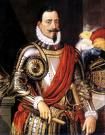


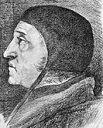
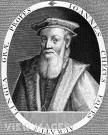








1540 I can't see me loving nobody but you, for all of, er, some of my life? Grand Canyon jokes here? On Jan. 1 Henry VIII has a comical meeting with Anne of Cleves (1515-57) in disguise in Rochester, and finds her portrait quite exaggerated and her person loathsome, then tries to back out of his marriage, but power politics prevents him, and on Jan. 6 he reluctantly marries his 4th wife to bring about an alliance with a German principality and counter the Treaty of Toledo; in Apr. Henry creates his chief minister Thomas Cromwell (b. 1485) the earl of Essex, then turns on him after having many impotent nights with his new wife (who has big floppy duckies instead of pert little ones like he likes?, blaming him for hooking him up with an ogre, letting Cromwell's enemies loose on him; on June 10 Cromwell's archenemy, lord treasurer Thomas Howard, 3rd Duke of Norfolk (1473-1554) arrests him for treason, and Parliament turns on him too; meanwhile on July 9 Henry divorces Anne at the convocation of Canterbury and York, giving her the title of "My Lady the Queen's Sister", then on July 30 secretly marries his real lover, the very tight and right Catherine Howard (1521-42) (his 5th wife), Anne Boleyn's cousin, and niece of Thomas Howard, 3rd duke of Norfolk; the same day Thomas Cromwell is executed after reconverting to Roman Catholicism, and Norfolk becomes his successor; the same day English Lutheran Robert Barnes (b. 1495) is burned at the stake; Bible translator Miles Coverdale flees to the Continent for the next eight years (until 1548); too bad, Catherine begins secretly hooking up with handsome young stud Thomas Culpeper (1514-41) with the aid of her lady-in-waiting Jane Boleyn, Viscountess Rochford (1505-42), widowed sister-in-law of Anne Boleyn - moral: please the head of your nation or you could lose yours? Don't just take your family on a vacation, take them on an adventure? Whitey finally reaches the far side, and it's gone in a flash? On Feb. 23 Francisco Vazquez (Vázquez) de Coronado (1510-54), gov. of Nueva Galicia leads an expedition of 400 men plus 1.3K-2K Indios, four Franciscan monks, and several slaves from Compostela, Mexico, exploring N Texas and invading New Mexico and conquering the Zunis (Zuñis); on Sept. 8 they establish winter HQ at the Indian pueblos of Kuau and Puaray, using it as a base for vain searches for the riches of Quivira; in 1934 archaeologists unearth ancient paintings of Indian god-demons behind 85 layers of adobe plaster; on May 9 Spanish navigator Hernando de Alarcon (Alarcón) leaves Coronado's party, goes by sea to the Gulf of Calif., then completes the explorations of Francisco de Ulloa the preceding year, satisfying himself that there is no open water passage between the gulf and the South Sea (Pacific Ocean); he then travels up the Colorado River (which he names the Buena Guia), becoming the first Euro to navigate it, viewing Am. bison (buffalo) ("tatanka"); Garcia Lopez de Cardenas (García López de Cárdenas) leaves Coronado's party and discovers the Grand Canyon and the Colorado River in modern-day Ariz.; another lt. of Coronado reaches the pueblos of the Hopi (Moqui); Capt. Hernando de Alvarado leaves Coronado's party and explores the Rio Grande River, stopping halfway at Isleta Pueblo (S of modern-day Albuquerque), which becomes a stopping place for every future Spanish explorer in New Mexico. On Feb. 28-Sept. 19 the European Super Drought of 1540 causes Milan, Italy to be completely dry for 5 mo., while in Zurich it only rains 4x, causing the water table in Switzerland to drop over 1.5M and thousands along the Ruhr River to die of poisoning from dirty water; Lindau Island becomes connected to the mainland after the water level in the Bodensee sinks; the water flow in the Elbe River is reduced to one-tenth normal, allowing people to walk across them, along with the Rhine and Seine Rivers; by Aug. trees begin shedding their leaves early, after which fires destroy more communities than in the preceding millennium, causing a blanket of smoke to shroud Europe, turning the Sun and Moon into flaming red balls; prices for flour and bread zoom sky high. In Mar. Pedro de Valdivia (Valdavia) (1497-1553), who began working for Francisco Pizarro in 1535 and helped him fight Diego de Almagro (the N part of Peru had been under Almagro's jurisdiction) leads an expedition of 150 Spanish soldiers plus some Peruvian Indians across the Atacama Desert into the C valley of Chile, accompanied by his babe Ines Suarez. In the spring James V of Scotland launches a naval expedition to the Scottish N and W Isles, and returns to Edinburgh in early July with a number of hostages, which are secreted in the castles of Dunbar, Tantallon, and Bass Rock to keep their unruly chieftains in line. In the spring the simmering hatreds caused by the abuses of Nuno de Guzman in La Gran Chichimecha in NC Mexico cause the natives of Nueva Galicia to revolt in the Mixton (Mixtón) Rebellion (War), which New Spain viceroy Antonio Hurtado de Mendoza ruthlessly quashes by next Dec. In Apr. Hungarian king (since 1526) John I Zapolya (b. 1487) finally finds out he has a son in the oven, John II Sigismund Zapolya (1540-71)), causing him to rescind his agreement to let his rival Ferdinand I claim the Hungarian throne upon his death; he dies on July 22, nine days after John is born, and Zapolya's royal counselor, Dalmation-born monk (later cardinal) George Martinuzzi (AKA Frater Georgius) (1482-1551) becomes regent for John II, along with secret Protestant Peter Petrovich, claiming the throne for the young tyke, backed by the Turkish sultan and other enemies of the Hapsburgs, but Ferdinand I continues to claim Hungary and sends an army which sieges Ofen, giving the sultan his excuse to invade Hungary in support of the tyke - pour me another cup of coffee? In May Sebastian de Belalcar is granted governorship of Popayan by HRE Charles V, soon getting into a border dispute with new neighboring province gov. (until 1542) Pascual de Andagoya (1495-1548). On Aug. 28 Federico II Gonzaga (b. 1500) dies of syphilis, and his son Francesco III Gonzaga (1533-50) becomes duke of Mantua and marquis of Monteferrat (until 1550), going on to marry a daughter of Ferdinand I in 1549 to cement his position. In Aug. Scottish master of works Sir James Hamilton of Finnart (-1540) AKA "the Bastard of Arran" (bastard son of James Hamilton, 1st Earl of Arran and Mary Boyd of Bonshaw, legitimated in 1512), who had tried to get Archibald Douglas of Kilspindie rehabilitated in 1529 is executed for plotting to kill his 2nd cousin James V, who confiscates his considerable wealth - thanks, suckah? On Sept. 3 Gelawdewos (Claudius) (1521-59) is crowned Solomonic emperor Asnaf Sagad I of Ethiopia (until Mar. 23, 1559). On Sept. 27 Pope Paul III issues the bull Regimini Militantis Ecclesiae, confirming the Jesuit Order (Society of Jesus) of (St.) Ignatius of Loyola (1491-1556), but limiting its membership to 60 (until 1543); Loyola is appointed superior-gen. #1 of the Jesuits, becoming known for opposing discrimination against converted Jews, calling the Spanish insistence on "purity of blood" (discrimination against Catholics of Jewish ancestry) "the Spanish whim". In Oct. after the Ottomans take their remaining outposts in the Ionian and Aegean Seas, Venice signs a peace treaty with Ottoman Sultan Suleiman I the Magnificent in Constantinople, agreeing to recognize the Turkish territorial gains and pay 300K gold ducats. Gonzalo Pizarro receives reinforcements then continues chasing Manco and his Incas through steamy jungles, finding his jungle city abandoned, then searches for 2 mo. more before giving up and returning. Ottoman adm. Barbarossa II sacks Spanish-held Gibraltar, causing Charles I of Spain (HRE Charles V) to order stronger defenses built; in Sept. he tries to induce Ottoman adm. Barbarossa II Heyruddin to switch sides, offering him a job as adm.-in-chief plus control of Spain's territories in N Africa, but he tells the infidel dog to stuff it. The property of the Hospitallers (Knights of Rhodes) in England is confiscated. Scottish Queen Mary of Guise is crowned at Holyrood with a newly-remodelled crown. A religious conference is held in Worms (ends 1541), where Johann Eck et al. defend Your Father's Roman Catholicism against uppity horned Lutherans. Spanish conquistador Pedro Cieza de Leon (1520-54) discovers the ruins of Tiahuanaco in the Peruvian-Bolivian altiplano 12 mi. S of Lake Titicaca. Speaking of horned monarchs, Henry VIII arbitrarily decides that no horse stallion in his realm should be shorter than 15 hands, 13 for mares, causing breeds like the Cornish to be extinguished, and others like the Exmoor and Dartmoor to get taller; he orders every archbishop and duke to keep seven trotting stallions of min. height 14 hands at age 3, and every person having benefices of 100 pounds a year along with "every layman, whose wife shall wear any French hood or bonnet of velvet" to keep one trotting stallion. After the Portuguese bring sugar cane to Brazil, Santa Catalina Island boasts 800 cane sugar mills; the N coast of Brazil, Demerara, and Suriname have 2K more. In this decade the Protestant Reformation is introduced to Brandenburg, Germany, and its electors become leading champions of the Protestant cause. The Antinomian Controversy in Germany (how faith in Christ frees believers from all obligation to observe the moral laws of the Old Testament, therefore let's do it here now and not worry about it) ends when its backer Johann Agricola (Schnitter) (1494-1566) pub. a retraction (of course being no longer obligated doesn't mean that one shouldn't do it voluntarily, since Christ is in the heart now, therefore to go against his will would be a sin against the Holy Spirit and therefore unforgivable?) - crying out, Merry Christmas, my friend? A large Spanish force led by Francisco de Montejo El Mozo (The Son) (1502-65), son of Francisco de Montejo y Alverez (1479-1553), along with brothers Gaspar Pacheco and Melchor Pacheco leave Tabasco, Mexico to begin the their 2nd and final attempt at the conquest of Yucatan (ends 1546). The seaport of Campeche in Mexico, named after the local logwood (palo de campeche) is founded on the site of a native village at the mouth of the San Francisco River, becoming one of three open ports on the coast of the Gulf of Campeche in the Gulf of Mexico. Valladolid la Nueva (later Comayagua) on the Humuya River (70 mi. NW of Tegucigalpa) is founded in Honduras as the admin. center of the Spanish colonial govt. midway between the Atlantic and Pacific Ocean by New Spain viceroy Antonio Hurtado de Mendoza. Icelander John Greenlander finds a Skraeling corpse at the site of the extinct Greenland west coast settlement, made unable to fish or raise crops by glaciers moving into the fjords; "By him lay his iron knife, bent and almost worn away." By this time the Romani and Sinti from India arrive in Germany, splitting into the Eftavagarja (Seven Caravans), which migrate to France, Portugal and Brazil (becoming the Manouches), and the Estraxarja (From Austria), who migrate to Italy and C Europe. James V of Scotland orders the crown remodelled. The English Parliament legalizes the growing of hops. The Worshipful Co. of Barbers and the Guild of Surgeons merge to form the Co. of Barbers and Surgeons, led by Henry VIII's royal surgeon Thomas Vicary (1490-1561), with both professions allowed to extract teeth; in 1546 Vicary becomes suptd. #1 of St. Bartholomew's Hospital; the barber pole begins displaying red stripes for surgery and white ones for haircutting and teeth extraction; barbers are paid higher wages until surgeons begin working on British ships during naval wars; the co. is licensed to perform dissections of the cadavers of executed criminals, with four held each year in Barber-Surgeon's Hall, with Vicary establishing the first formal teaching of anatomy in England; in 1745 the surgeons break away to form the Co. of Surgeons. Henry VIII founds regius professorships of Greek, Hebrew, divinity, civil law, and physics at Oxford U. and Cambridge U.; Sir John Cheke (Cheek) (1514-57) becomes the first regius prof. of Greek at Oxford, and Roger Ascham (1515-68) at Cambridge. Jean Clouet's son Francois Clouet (1510-72) becomes court painter to Francis I. Francois Rabelais moves to Paris and reads his hit books "Gargantua" and "Pantagruel" to Francis I, which pleases him so much that he grants a license to pub. Bk. 3; meanwhile Rabelais is invited to Turin to be the physician of gout-stricken William du Bellay (d. 1543), staying until 1542 writing Bk. 3, which is pub. in 1546. In this decade the univ. town of Padua, Italy begins keeping a botanical garden; the first one in Europe? In this decade Antwerp in Belgium becomes an important commercial city. In this decade stage comedians in N Italy create improv. Inventions: Blue ribbon for best complementary inventions in the same year? French surgeon Ambroise Pare (Paré) (1510-90) invents the first Artificial Limbs. Italian munitions manufacturer Camillo Vettelli begins producing the first Pistols (for horse soldiers) at (guess where?) Pistoia in Tuscany (21 mi. NW of Florence), all made possible by the invention of the wheel lock; Henry VIII ends up owning a 4-chamber arquebus with a 2'9" barrel, 7.5" chamber, and 0.5" bore; others begin combining the pistol with a battle-axe or dagger - I'll pare off those lame legs after you come to be ventilated by a pistol? Science: Ether is first produced from alcohol and sulfuric acid by ?. After being forced to flee to Paris and change his name to Villanovus, Freethinking Spanish physician Michael Servetus (1511-53) discovers the Pulmonary Circulation of the Blood. Nonfiction: Petrus Apianus (1495-1552), Astronomicum Caesareum; dedicated to HRE Charles V; notes that the tail of a comet observed in 1531 pointed away from the Sun, and incl. the first scientific drawing of a comet. Vannoccio Biringuccio (1480-1539), De la Pirotechnica (posth.); first prof. handbook of metallurgy, smelting, ore reduction, and cannon-molding, and first modern book on how to operate a foundry. Thomas Cranmer (1489-1556), Cranmer's (Great) Bible; revised ed. of Miles Coverdale's Great Bible of 1539. Georg Joachim Rheticus (1514-74), Narratio Prima de Libris Revolutionum; announces Nicolas Copernicus' heliocentric theory in advance; states that medicine could achieve the perfection to which Copernicus had brought astronomy - there are 206 what and over 700 what in the human body? Julius Caesar Scaliger (1484-1558), Commentarii in Hippocratis Librum de Insomniis; De Causis Linguae Latinae Libri XVIII; first modern work on the syntax of Latin. Augustinus Steuchus, De Perenni Philosophia. Art: Jacopo Bassano, Flight into Egypt. Agnolo Bronzino (1503-72), An Allegory (Venus, Cupid, Folly and Time). Il Sodoma (1477-1549), Pieta. Titian (1477-1576), A Young Englishman; Cain Killing Abel; Sacrifice of Abraham; David and Goliath (Church of the Salute, Venice); shows the influence of Michelangelo in emphasizing muscular form. Plays: Sir David Lindsay (1490-1555), Ane Pleasant Satyre of the Thrie Estaitis (morality play). Births: English Roman Catholic Jesuit priest-martyr (St.) Edmund Campion (d. 1581) on Jan. 24 in London; educated at St. John's College, Oxford U.; starts out Protestant, rises to being put in line for archbishop of Canterbury, then goes Roman Catholic in 1571 so he can get some of them tasty wafers, and ends up hanged, drawn, and quartered when he tries to upend Queen Liz. English statesman (crypto-Roman Catholic) Henry Howard, 1st Earl of Northampton (d. 1614) on Feb. 24 in Shottesham, Norfolk; younger brother of Thomas Howard, 4th duke of Norfolk (1536-72); "The leadernedest councillor in the kingdom to present to the king his Advancement of Learning" (Francis Bacon). Dutch (Flemish) "The Wilhelmus", "The Roman Beehive" writer-statesman (first Dutch cryptographer?) Philip (Philips) van Marnix, Lord of Sainte-Aldegonde (Marnix van St. Aldegonde) (d. 1598) on Mar. 7 (July 2?) in Brussels; son of Jacob van Marnix, baron of Pottes; pupil of John Calvin and Theodore Beza. Indian maharana of Mewar (1572-97) Pratap Singh I (d. 1597) on May 9 in Kumbhalgarh (Rajsamand). Spanish aristocrat (blind in the right eye) Ana de Mendoza de la Cerda y de Silva Cifuentes, Princess of Eboli, Duchess of Pastrana (d. 1592) on June 29 in Cifuentes, Guadalajara; wife (1553-73) of Ruy Gomez de Silva, 1st prince of Eboli (1516-73). Hungarian king (1540-70) John II Sigismund Zapolya (Zápolya) (d. 1571) on July 7 in Buda; son of John Zapolya (1487-1540) and Isabella Jagiello (1519-59). French Protestant #1 Renaissance classical scholar ("Father of Chronological Science") Joseph Justus Scaliger (d. 1609) on Aug. 4 in Agen; 10th child and 3rd son of Julius Caesar Scaliger (1484-1558); inventor of the Julian Day system; educated at the U. of Paris; reads the works of Homer in 21 days and all the other Greek poets in 4 mo.? English countess Lady Catherine (Katherine) Grey, Countess of Hertford (d. 1568) in Aug.; younger sister of Lady Jane Grey. French poet Pierre de Boscosel de Chastelard (d. 1564) in Dauphine; grandson of Chevalier de Bayard (1476-1524); crazy in love with Mary, Queen of Scots. Spanish world chess champion #1 and Roman Catholic priest-bishop Rodrigo "Ruy" Lopez de Segura (d. 1580) (b. 1530?) in Zafra (near Badajoz); of Marrano Jewish descent; moves to Salamanca. German serial murderer Peter Niers (d. 1581). Spanish adm. Don Juan Martinez de Recalde (d. 1588) in Bilbao, Biscay. English lord chancellor (1587-91) Sir Christopher Hatton (d. 1591); educated at St. Mary Hall, Oxford U.; knighted in 1578. English painter and Am. colonist John White (d. 1593) in London; half-brother of Sir Walter Raleigh; grandfather of Virginia Dare (1587-). English painter, er, writer-translator William Painter (Paynter) (d. 1595) in Kent; educated at St. John's College, Cambridge U. English noblewoman Margaret Stanley, Countess of Derby (d. 1596); 3rd daughter of Henry VII and Elizabeth of York; heir to Elizabeth I under the Third Succession Act; mother of William Stanley, 6th earl of Derby (1561-1642). Italian-Dutch painter-architect Friedrich Sustris (d. 1599 in Padua; son of Lambert Sustris (1515-84); son-in-law of Jan Kraeck (1540-1607); pupil of Giorgio Vasari. French mathematician (Roman Catholic) Francois Viete (Viète) (Franciscus Vieta), Seigneur de la Bigotiere (Bigotière) (d. 1603) in Fontenay-le-Comte, modern-day Vendee; educated at the U. of Poitiers; starts out as an atty. Italian composer Orfeo Vecchi (d. 1604). French biographer Pierre de Bourdeilles, Seigneur de Brantome (d. 1614) in Perigord. English Roman Catholic polyphonic church music organist-composer ("Father of Musick") William Byrd (Birde) (d. 1623) in Lincolnshire; pupil of Thomas Tallis (-1585); foremost composer of the Elizabethan age. English free man Thomas Francklyne (Franklyne) (Franklin) ("freeman") (d. ?) in Ecton, Northamptonshire; great-great-grandfather of Benjamin Franklin. Deaths: Portuguese explorer Tristao da Cuha (b. 1460). French scholar Guillaume Bude (b. 1467) on Aug. 23 in Paris; his wife moves to Geneva and becomes a Calvinist, and coupled with his request to be buried at night it leaves the suspicion that he is one too, causing his family to flee to Switzerland during the St. Bartholomew's Day Massacre of 1572; leaves Notes on the 24 Books of Pandects (pub. 1508), using philology and history to throw light on the study of Roman law. Italian Ursulines founder St. Angela Merici (b. 1474) on Jan. 27 in Brescia. English knight Sir William Kingston (b. 1476) on Sept. 14 in Painswick. Italian statesman-historian Francesco Guicciardini (b. 1483) on May 22 in Arcetri; leaves The History of Italy (Storia d'Italia) (20 vols.), covering 1494 to 1534, "the one work he wrote not for himself, but for the public" (Felix Gilbert); pioneers the use of govt. documents to support arguments, and a realistic analysis of people and events, which is first pub. in 1561, followed by an English trans. in 1579. "Francesco Guicciardini might be called a psychological historian - for him the motive power of the huge clockwork of events may be traced down the mainspring of individual behavior. Not any individual, be it noted, but those in positions of command: emperors, princes and popes who may be counted on to act always in terms of their self-interest - the famous Guicciardinian particolare." (Sidney Alexander) "The young historian was already doubtlessly aware of the meaning of historical perspective; the same facts acquiring different weight in different contexts, a sense of proportion was called for." (Nicolai Rubinstein) "Machiavelli and Guicciardini are important transitional figures in the development of historical writing. The historical consciousness that becomes visible in their work is a significant rupture in our thinking about the past... Human agency was a central element in the historical thought of Machiavelli and Guicciardini, but they did not have a modern notion of individuality... They started to disentangle historiography from its rhetorical framework, and in Guicciardini's work we can observe the first traces of a critical historical method." (Sidney Alexander) "If we consider intellectual power [the Storia d'Italia] is the most important work that has issued from an Italian mind." (Francesco de Sanctis) English statesman Thomas Cromwell, earl of Essex (b. 1485) on July 28 (beheaded). Hungarian king (1526-40) John Zapolya (b. 1487) on July 22. Spanish humanist scholar Juan Louis Vives (b. 1492) on May 6 in Bruges; leaves De Causis Corruptarum Artium. Italian painter (at Fontainebleau) Rosso Fiorentino (b. 1494) in Paris. English Lutheran reformer Robert Barnes (b. 1495) on July 30 (burned at the stake). Italian duke of Mantua (1519-40) Federico II Gonzaga (b. 1500) on Aug. 28 in Marmirolo (congenital syphilis). Italian painter Parmigianino (Francesco Mazzola) (b. 1503) on Aug. 24 in Casalmaggiore - make my veal parmigiana kosher? French mistress (of Francis I) Ferronier (b. ?); wife of the lawyer Le Ferron, who allegedly contracted syphilis in the hopes of passing it to the king through the beautiful one I love?












1541 On Feb. 12 after penetrating Chile's central valley, Pedro de Valdivia founds the city of Santiago (Del Nuevo Extremo) (modern-day pop. 7.3M); hostile Indians siege the settlement until reinforcements from Peru arrive in Dec. 1543; once the city is established, he dumps his babe Ines Suarez? In late Feb. Gonzalo Pizarro leads an expedition from Quito into Amazonia with 220 conquistadors, 4K highland natives, and 200 horses in search of the fabled rich El Dorado; the jungle can't support the natives and they all die of starvation, while the Spanish are reduced to eating their horses; they find a waterfall allegedly containing the gold of Atahualpa, but don't find any; on Nov. 9 they reach the Coca River, and by Christmas are on the verge of starvation; after a boat is built using melted-down horsehoes for nails, Francisco de Orellana (1511-46) leads 57 men, incl. Dominican missionary (chronicler and mapmaker) Father Gaspar de Carvajal (1500-84) on a food-gathering expedition, promising to return in a few days, but the current is too strong and they can't return, so they begin descending the network of rivers leading into the Amazon, getting into an epic lock-up-your-daughter adventure (ends 1542), which Carvajal records in his cool Journal of Gaspar de Carvajal. On Apr. 7 Spanish Jesuit missionary ("Apostle of the Indies") (St.) Francis Xavier (Francisco de Jasso y Azpilicueta) (1506-52) leaves Lisbon aboard the Santiago carrying a letter from the pope appointing his apostlic nuncio to the East, reaching Portuguese Mozambique in Aug., then leaving next Mar. for Goa, arriving on May 6 and becoming head of Saint Paul's College, which becomes the first Jesuit HQ in Asia; in Oct. 1542 he sails for the Pearl Fishery Coast at Cape Comorin, converting the Paravas, while failing to reach the high-caste Brahmins but building almost 40 churches; in spring 1545 he sails for Portuguese Malaca, leaving in Jan. 1546 for the Maluku Islands, starting with Ambon Island and returning to Malacca in summer 1547. On May 8 after failing to find the fabled Mayan city of Yupaha (discovered in 2011 near Brasstown Bald Mt. in Ga.?), and reaching Mobile Bay in Ala., then fighting fierce Choctaw chief Tuscaloosa ("black warrior") (-1540), Spanish conquistador Hernando de Soto (1496-1542) and his 400 men discover the Mississippi River (2nd longest river in the U.S. after the Missouri River), and cross it near Randolph, Tenn., then explore Ark., becoming the first Euros to see Hot Springs, then Okla. and Tex. On May 23 Jacques Cartier begins his Third Voyage; in summer he and the Sieur de Roberval attempt to found the Charlesbourg-Royal settlement on the St. Lawrence River near the mouth of the Cap-Rouge River with 400 colonists; in Sept. 1543 after Indian raids, scurvy, and bad weather, it is abandoned. On June 26 Francisco Pizarro (b. 1470) is stabbed by the son of his first business partner in cahoots with Almagro partisans, who set up Almagro's mestizo son Diego de Almagro the Younger (-1542) as gov. of Peru, however royal judge Cristobal Vaca de Castro deposes him next Sept. 16 in a bloody battle in Chupas, and he is executed in Cuzco a few days later, ending the great Almagro name in Peru; Pizarro dies after conquering 480K sq. mi. of Inca territory from Ecuador S through the Andes to Bolivia. On Aug. 18 Duke Henry IV the Pious of Saxony (b. 1473) dies, and he wills that his lands be equally divided between his two sons Maurice I (1521-53) and Augustus I (1526-86), but after this is found contrary to Albertine law the elder son Maurice gets it all (until 1553). On Sept. 28 HRE Charles V personally leads an expedition of 500 ships incl. 80 galleys, 24K Spanish, Italian, and Spanish soldiers, and 12K sailors against Algiers, defended by 5K Ottoman troops and 800 Moors, arriving on Oct. 19, and disembarking troops on Oct. 23, surrounding the city except the N part; too bad, on Oct. 24 a storm disrupts his landing operations, and Adm. Andrea Dorea and old fart Hernan Cortes save some of the fleet from running aground, while Charles V is surrounded and saved only by the stiff resistance of 150 Knights of Malta, after which an indecisive land fight the fleet holes-up in Cape Matifu 5 mi. to the E, and departs for Spain on Nov. 23 after Charles V throws his horses overboard, reaching Cartagena on Dec. 3 with a loss of 130 carracks and 17 galleys plus hundreds of troops, leaving 12K men behind, who are massacred or taken captive, causing a glut on the A lgiers slave market, with Christian slaves going for the price of an onion; the disaster causes Charles V to give up trying to open Christian shipping in the W Mediterranean and lick his wounds. On Oct. 18 Margaret Tudor (b. 1489) dies in Methven Castle in Scotland. On Nov. 12 Queen Catherine Howard is sent to the Tower on suspicion of immoral conduct with Thomas Culpeper, whose chambers are searched, revealing a love letter from Catherine mentioning Lady Rochford, and they, along with Catherine's alleged paramour (when living with her grandmother the Duchess of Norfolk) Francis Dereham are tortured and executed on Dec. 10, Dereham getting the full treatment of hanging-drawing-quartering, and lucky Culpepper only beheading because of his Howard family connections; Catherine Howard is imprisoned in Syon House in Isleworth, NW London. After invading Tir Eogain, new (since July 7, 1540) lord deputy of Ireland Sir Anthony St. Leger (Sellenger) (1496-1559) defeats the Geraldine League and its leader Conn O'Neill, king of Tir Eogain, who is captured and sent to a parliament in Trim, then goes to England to convert to Protestantism and submit to Henry VIII, who creates him the 1st Earl of Tyrone and presents him with a nice gold chain and money, receiving land grants in the Pale in Balgriffin and being made a privy councillor in Ireland, pissing-off his Gaelic Roman Catholic clansmen and causing his son Shane O'Neill (1530-67) to begin a campaign to be recognized as The O'Neill despite the English and branches of his own family backing other claimants; meanwhile Henry VIII convenes the Irish Parliament to pass the 1542 Crown of Ireland Act on June 18, abolishing the high kingship of Ireland and changing his old title of lord of Ireland (conferred by the pope) to king of Ireland, making make him head of the Irish Church, discarding the old fiction that Ireland is a feudal province of the Church and that England was still a Roman Catholic country and establishing the new Kingdom of Ireland (ends Jan. 1, 1801); meanwhile in actual fact the Irish fight for every chance to break free from the stankin' English, who to them are nothing but plunderers - which only makes the Irish pop. more determined to never become Protestant? The Scottish Parliament passes laws to protect the honor of the Mass, prayer to the Virgin Mary, images of the saints, and the authority of the pope. Suleiman I the Magnificent invades and annexes Hungary, and occupies Ofen and the Hungarian capital of Buda on the pretext of protecting infant king John II, setting it up as capital of a Turkish province along the Danube River, which remains in Ottoman hands for 147 years (until 1688), splitting Hungary into three parts, ruled by the Ottomans, the Hapsburg monarchy of Austria, and the principality of Transylvania; Suleiman I allegedly tricks Hungarian gen. Count Balint Torok (Bálint Török) de Enying (1502-51) by inviting him to a sumptuous dinner in his tent and giving him the first coffee tasted by a Euro, while sending his best soldiers to take Buda Castle; meanwhile John II's mommy Isabella continues to rule the principality of Siebenurgen, while the stern rule of George Martinuzzi (1482-1551) causes a cabal against him, which he responds to by switching over to Ferdinand I's side and entering secret negotiations with him. Francisco Vazquez de Coronado sets out from New Mexico on a 2K-mi. expedition across N Tex., the Okla. Panhandle, and E Kan. in search of the fabled rich Seven Cities of Cibola, esp. the city of Quivira (ends 1542); he carves his name and the date on a rock while searching for gold near the Cimarron River 20 mi. from modern-day Kenton, Okla. where the Santa Fe Trail later crosses the river, returning to Mexico City next spring with empty saddlebags after failing to find the fabled Seven Cities of Cibola; meanwhile Hernando de Soto explores the E border of Okla. The Mayans are finally subdued by the Spanish - that's 1521 for the Aztecs, 1531 for the Incas, and 1541 for the Mayans, aim and fire, bada bing, bada boom? An earthquake cracks the water-filled crater of the Agua Volcano (Volcan del Agua), flooding Guatemala City, causing a new capital to be built at Antigua Guatemala (27 mi. from modern-day Guatemala City). The Ottomans seal the Golden Gate on the walls of the Old City of Jerusalem to prevent a possible entrance by the Jewish and/or Christian Messiah, putting a cemetery in front because it's taboo for a Jewish priest to walk through one. A religious conference is held in Ratisbon in Germany, where Johann Eck continues defending Roman Catholicism; meanwhile John Calvin (1509-64) returns to Geneva, which until his death in 1564 becomes his stronghold, and founds the Presbyterian Church, which spreads to Scotland in 1560 via his disciple John Knox, and becomes the state church of Scotland in 1592 - they were smart enough to abandon the corrupt Mother Church, but not smart enough to avoid becoming established churches that persecute enemies like it does? Henry Howard, Earl of Surrey (1517-47), son of Thomas Howard, 3rd duke of Norfolk is made knight of the garter, and in 1543 joins the English army in France, where his prowess gains him the title of field marshal, becoming the man in England needing to wear shades, his future is so bright? Alvar Nunez Cabeza de Vaca leads an expedition through the Rio de la Plata (ends 1542), discovering Iguazu ("big water") Falls on the border of modern-day Brazil and Argentina, largest waterfall on Earth. Architecture: The elaborate Renaissance Lonja (Exchange) de Zaragoza in Saragossa, Spain is begun (finished 1551). Nonfiction: Domingo del Castillo, a pilot for Hernando de Alarcon draws a Map of the Baja Calif., the Gulf of Calif., and the Lower Colorado River. Science: Italian anatomist Giambattista Canano (Canani) (1515-79) pub. an anatomical tract that shows each muscle separately in its relations with the bones. Nonfiction: Johann Eck (1486-1543), Against the Defenses of the Jews; virulent anti-Semitic pamphlet claiming that any attempt by "Jew protector" Andreas Osiander to claim that the "blasphemous race" doesn't kill Christian kids and desecrate the eucharistic host is full of scheisse; "Could they but drown all Christians in one spoon, they would eagerly do it"; a Roman Catholic equals or bests Martin Luther in anti-Semitic rhetoric? Georg Joachim Rheticus (1514-74), Tabula Chorographica auf Preussen und Etliche Umbliegende Lender (Map of Prussia and Neighboring Lands); presented to Duke Albrecht of Prussia. Art: At least it won't drip in my face anymore? Michelangelo (1475-1564), The Last Judgment (1536-41); fresco on the wall of the Sistine Chapel behind the altar of St. Peter's; unveiled on Dec. 25 (Christmas Day); depicts the horrors of ending up in hopeless, faithless, loveless, naked Hell as a result of one's sins, causing Pope Paul III to fall to his knees in fear, mumbling "Lord, save me from my sins on the Day of Judgment"; Michelangelo rejects classical proportions in favor of movement and dramatic effect, and portrays himself as St. Bartholomew, holding his skin after being flayed, showing his contempt for having to do the job; he puts the pope's master of ceremonies Biagio da Cesena in the lower right corner as Minos, judge of the underworld (complete with ass ears) after he criticizes the ignudi (nude figures) on the ceiling; the fresco is painted on the spot where a portrait of Pope Sixtus IV had been erased by Medici Pope Clement VII to get even for the 1478 Pazzi Plot; the abundance of ignudi sparks a "Fig Leaf Campaign", organized by rich, high-living but religiously ultra-orthodox statesman (later archbishop of Naples and cardinal) Oliviero Carafa (1430-1511) and Monsignor Sernini (ambassador of Mantua), who get Daniele Ricciarelli da Volterra (1509-66) hired in 1565 (after the Council of Trent condemns nudity in religious art) to paint over the genitalia, earning him the nickname Il Braghettone (the breeches painter); since St. Blaise (holding his iron combs) is shown behind St. Catherine (holding her breaking wheel) looking at her naked ass, he chisels them both off and repaints them; luckily, Pope Pius IV dies at the end of 1565, and his scaffolding is taken away for the new papal elections, stopping him from messing up the lower half of the fresco; "It was mostly disgraceful that in so sacred a place there should have been depicted all those nude figures, exposing themselves so shamefully, and that it was no work for a papal chapel but rather for the public baths and taverns" (Biagio da Cesena); meanwhile in Dec. Daniele gets a commission to do a series of frescoes in the Orsini Chapel in the Trinita dei Monti, and Michelangelo gives him some sketches to use. Plays: Giovanni Cinzio Giraldi (1504-73), Orbeche (tragedy). Poetry: Clement Marot (1496-1544) and Theodore Beza (1519-1605), Trente Psaumes; a trans. of the Psalms, which becomes wildly popular and advances the cause of the Reformation after being adopted by John Calvin; condemned by the Sorbonne, making it more popular? Births: French "Satire Menippee" poet (in Latin) (Calvinist-turned-Roman Catholic) Florent Chrestien (d. 1596) on Jan. 26 in Orleans; student of Henri Estienne; tutor of Henry IV. Italian grand duke of Tuscany (1574-87) Francesco I de' Medici (d. 1587) on Mar. 25 in Florence; son of Cosimo I de' Medici (1519-74). English earl marshal Walter Devereux, 1st Earl of Essex (d. 1576) on Sept. 16; eldest son of Sir Richard Devereux (-1547) and Dorothy Hastings, daughter of Henry VIII's mistress Anne Stafford; Ottoman historian Mustafa Ali (d. 1600). Polish patriot Jan Zamoyski (d. 1605). English secy. of state William Davison (d. 1608); of Scottish descent. French (Gascon) Huguenot writer-historian Lancelot Voisin de La Popeliniere (Popelinière) (d. 1608). Spanish-Greek Mannerist painter El Greco (Domenikos Theotokopoulos) (d. 1614) in Heraklion, Crete (Repub. of Venice); settles in the old Jewish quarter of Toledo. Greek Catholic Church founder Ipaci Pocei (b. ?). Deaths: Spanish conquistador Francisco Pizarro (d. 1470) on June 26 in Lima (stabbed); dies after conquering 480K sq. mi. of Inca territory from Ecuador S through the Andes to Bolivia. English countess Margaret Pole of Salisbury (b. 1473) on May 27 in the Tower of London (executed); last member of the House of Plantagenet other than her son Cardinal Reginald Pole (1500-58), who says he will "never fear to call himself the son of a martyr"; the beheading is bloodily botched, requiring 11 axe strokes; beatified on Dec. 29, 1886 by Pope Leo XII. German Protestant Saxon duke (1539-41) Henry IV the Pious (b. 1473) on Aug. 18 in Dresden. Italian astronomer-diplomat Celio Calcagnini (b. 1479) in Ferrara. French portrait painter Jean Clouet (b. 1480). Spanish sculptor Damia Forment (b. 1480) in Santo Domingo de la Calzada; dies after completing the Renaissance altar of the Cathedral of Santo Domingo de la Calzada (begun 1537). Lithuanian grand hetman Jerzy Radziwill (b. 1480) in Apr. German magician Johann Georg Faust (b. 1480) in Staufen im Breisgau; dies after an alchemical explosion in Hotel zum Lowen, his "greviously mutilated" body whose face kept turning to the ground despite the body being turned on its back being taken as proof that the Devil hd personally come to collect. Spanish conquistador Pedro de Alvarado (b. 1486) in Mexico; killed in an Indian revolt. German Protestant leader Andreas Bodenstein von Karlstadt (AKA Brother Andrew) (b. 1486) on Dec. 24. Scottish queen (1502-13) Margaret Tudor (b. 1489) on Oct. 18 in Methven Castle, Perthshire. Jewish mystery man David Reubeni (b. 1490) (d. 1535?) in Spain (Portugal?). German-Swiss physician-alchemist-philosopher Paracelsus (b. 1493) on Sept. 24 in Salzburg; dies having failed to find the "alkahest" (universal solvent) (a term he coined): "Medicine is not only a science, it is also an art"; "So I have traveled throughout the land and was a pilgrim all my life, alone and a stranger feeling alien. Then Thou has made grow in me Thine art under the breath of the terrible storm in me." Flemish composer Wulfard Hellinck (b. 1496). English courtier Thomas Culpeper (b. ?) on Dec. 10 in Tyburn (beheaded). Am. courtier Francis Dereham (b. ?) on Dec. 10 in Tyburn (executed).


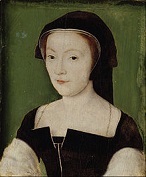





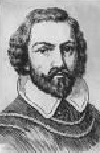
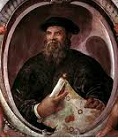

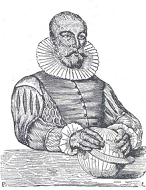
1542 In the last 50 years 300K Spaniards have emigrated to the New World, while the cruel mistreatment of the Caribbean aborigines has almost exterminated them; the Spanish monarchs finally ban the enslaving of Caribbean natives this year (what's left of them). On Jan. 6 after horribly kicking a bunch of Mayan butt, the Spanish under Francisco de Montejo El Mozo set up their capital in the Mayan city of T'ho, which they rename Merida (Mérida); the lord of Mani converts to Roman Catholicism, aiding the conquest of the rest of the peninsula; meanwhile on Nov. 20 the Spanish audiencia of Confines de Guatemala y Nicaragua is established, with jurisdiction over Chiapas and Guatemala, adding Yucatan in 1549 (until 1560). On Jan. 8 Francisco de Orellana's expedition reaches the Napo River ("River of Cinnamon"), and they become the first Europeans to enter Amazonia, visiting the Lumara and other Indian tribes along the way, and building a dictionary of their languages while infecting them with white man's diseases incl. smallpox; meanwhile, Gonzalo Pizarro and his starving men finally give up on them and turn back, fighting hostile Indians and the elements in an epic hellish struggle before a pitiful few straggle back half-naked with only their swords, Pizarro swearing that Orellana is "the worst traitor that ever was" and vowing to have him executed; by this time Orellana's party finds lodging with the Apurina (Apurinã) people on the Purus River, and rests for 2 mo. while building a 30-ft. boat, leaving in late Apr. to finish the remaining 2K mi. down the river to the Atlantic, passing the Lost Empire of the Amazon (the Amajua Confederation), crossing the border into Brazil, passing the Rio Negro (Negro River) (with inky black water that flows for 430 mi. before mixing with the silty water of the Amazon River), and finally reaching the mouth of the Amazon River in Aug. after 8 mo. and 2.5K mi. on the river with 47 survivors; after beating the treason charges with his cool Journal, he returns to Spain, gets appointed gov. of Amazonia, spends 11 mo. trying to find the mouth again, and dies in parts unknown. On Feb. 13 after more evidence is dug up and a bill of attainder passed by Parliament, Henry VIII's 5th wife Catherine Howard (b. 1520) is executed in the Tower of London on charges of adultery, becoming the last wife he executes; her lady-in-waiting Jane Boleyn, viscountess Rochford (b. 1505) (who had gone insane, causing the king get a law passed allowing the execution of the insane) is executed next after giving a long speech showing she wasn't really?; not that all the Howards are in equal trouble, as her uncle Thomas Howard, 3rd duke of Norfolk is sent to lead an English expedition into Scotland with his son Henry Howard, although he loses his influence at court. In the spring Francisco Vazquez de Coronado returns to Mexico City with empty saddlebags after failing to find the fabled Seven Cities of Cibola - you-u-u-u made me leave my happy home? On May 21 Spanish explorer Hernando De Soto (b. 1496) dies of fever in the Indian village of Guachoya on the banks of the Mississippi River near modern-day McArthur, Ark.; his men, who had been trying to palm him off as a god try to disguise his death and sink him in the river in the night, but the natives see through it, and the expedition decides to return home, building ships and sailing in July down the Mississippi River, continuing to the Panuco River, where they find refuge in the Spanish frontier town of Panuco, then return to Mexico City a mo. later, with 311 of the original 620; the expedition was a dud, but it did leave horses and swine with the Indians, along with Euro diseases, causing permanent hostility. In May Jesuit missionary (St.) Francis Xavier (Francisco Javier) (1506-52) arrives in Goa after a 13-mo. sea voyage from Lisbon. In summer after pissed-off Roman Catholic peasants in Smaland in S Sweden under the leadership of Nils Dacke (-1543) start the Dacke War, a revolt against Lutheran king Gustavus I Vasa; next Aug. Dacke is killed, and the revolt is quashed. In July taking advantage of Spain's weakened navy, the Moors under Hassan Agha attack Mers El Kebir (Kébir) ("the Great Harbor"), harbor of Spanish-held Oran in NW Algeria. On Aug. 28 the Battle of Wofla near Lake Ashenge in Tigray, Ethiopia sees an army of 600-900 Ottoman musketeers and 20 Ottoman cavalry along with several thousand soldiers led by imam Ahmad ibn Ibrihim al-Ghazi (b. 1507), of the Muslim Sultanate of Adal crush a Portuguese expeditionary force of 290 musketeers and 23 Ethiopians, killing leader Cristovao da Gama (b. 1516) along with 160 Portuguese and eight Ethiopians, and capturing most of their muskets. In Aug. after Henry VIII renews his claim to be overlord of Scotland, the Scots under the earl of Huntly defeat the English under Lord Thomas Howard, 3rd duke of Norfolk at the Battle of Haddon Rig near Berwick, causing Norfolk to abandon his invasion of Scotland in Oct., and the Scots to plan an invasion of England. On Sept. 28 Portuguese navigator Juan Rodriguez Cabrillo (-1543), sent by New Spain viceroy Antonio de Mendoza in search of a northern strait discovers California (Calif.), landing at modern-day San Diego, and continuing N, discovering Monterey Bay on Nov. 16, and naming it Bahia de los Pinos because of the forest of pine trees; too bad, colonization is slow, and the first Spanish mission isn't founded until 1769 - why not call it Cabrillofornia? On Nov. 1 New Spain vicery Antonio de Mendoza sends an expedition of six galleons and 370-400 men led by Spanish explorer Ruy Lopez de Villalobos (1500-44) from New Spain to the "Islas del Poniente" (Islands of the West), taking Ferdinand Magellan's route, and after discovering Eniwetok (Enewetak) Atoll they enter Baganga Bay next Feb. 29, discovering Mindanao, which Lopez names Caesarea Karoll after Charles V, receiving a friendly reception, staying 32 days and suffering famine before leaving on Mar. 31, being intercepted by Portuguese ships wanting to know why there are trespassing on Portuguese territory; after hostile reception by the natives and more Portuguese, Villalobos is imprisoned by the Portuguese on Amboyna Island, where he dies next Apr. 4 after giving the name "Islas Felipinas" (Philippines) (after Charles V's son Philip II) to the Leyte region, which is later extended to the whole archipelago; 85 remaining crew members are shipped back to Lisbon on a Portuguese ship, and the rush to make the Philippines Philip's begins. On Nov. 2 HRE Charles V issues the New Laws of the Indies for the Good Treatment and Preservation of the Indians, inspired by Bartolome de las Casas, easing the plight of Indian slave labor; on Mar. 25 1544 New Spain viceroy Antonio Hurtado de Mendoza proclaims them; too bad, when the Spanish encomienda grant-holders balk, he takes a clue from what happened in Peru and revokes them. On Nov. 24 after a 15K-18K-man Scottish army under Robert Maxwell, 4th Lord Maxwell (1493-1546) (one of the ambassadors sent to France in 1537 to negotiate the marriage of James V to Mary of Guise) attempts to invade England, it is routed at the Battle of Solway Moss by a 3K-man English force led by Sir Thomas Wharton, 1st Baron Wharton (1495-1568) after James V unexpectedly places his favorite Sir Oliver Sinclair de Pitcairnis (St. Clair) (-1576) of Roslin (grandson of the Oliver Sinclair who completed Rosslyn Chapel in the 1480s) in charge of the Scottish army, who don't respect him and abandon the field, after which he is caught between a bog and a river, giving up after only a few are killed, Sinclair being captured along with 1.2K POWs, incl. Lord Maxwell and his eldest son Robert, who are kept as insurance for many years, the English rumoring that he preferred to be captured rather than face mean 30-y.-o. James V (b. 1511), who remains behind in Lochmaben, then hides in Falkland Palace in Fife, where he contracts a fever, then "turns his face to the wall and dies" (another untimely Stewart death) on Dec. 14 (same place where David Stewart was starved to death in 1402, then remodeled in the French style by James V), six days after the disappointing Dec. 8 birth in Linlithgow Palace (overlooking Loch Lothian) of Mary Stuart (Stewart), Queen of Scots (1542-87) to his French-born wife Mary of Guise (1515-60), who had borne sons James in 1540 and Arthur in 1541 only to see them both die in 1541, exactly like James IV's first two sons of the same names; on Dec. 14 Mary Stuart is declared queen, with James Hamilton, 2nd earl of Arran appointed gov. (regent); John Knox later claims that on his deathbed James V hears of the birth, then says, "It cam wi' a lass and it'l gang wi' a lass"; Sir Walter Scott later claims he used to visit his subjects incognito as "the guidman of Ballengreich". The 6-year struggle of the Danish party to throw out German counselors results in a Herredag in Copenhagen, with the charter amended requiring native-born Danes to fill high state offices, and the Danish nobles voting Christian III a 5% tax on their property to pay off the war debt owed the Germans and Holsatians. Pope Paul III establishes the Holy Office (Congregation for the Doctrine of the Faith) (Supreme Sacred Congregation of the Roman and Universal Inquisition) in Rome to intercept appeals from defendants of the Inquisition and forward them directly to the Holy See, ending up being used to speed up the persecution of scientists promoting Copernicus' heliocentric system - I'm feeling really nonjudgmental today? The Second Laws in Wales Act (first in 1535) completes the annexation of the legal system of Wales to England. HRE Charles V offers a 100 guilders reward for the arrest of Mennonite founder Menno Simons; by the year 2000 there are 1.3M Mennonites (why not Simonites?) in 65 countries, opposing the taking of oaths, military and govt. service, and favoring plain dress and living - the original Jehovah's Witnesses without the door-knocking? The real Shogun, not starring Richard Chamberlain? Antonio da Moto and other Portuguese sailors become the first Europeans to reach Japan when they land at small Tanegashima Island in Kagoshima (off the S coast of Kyushu) aboard a shipwrecked Chinese ship; the muskets they are carrying are quickly copied, and spread all over Japan; too bad, they also bring Jesuits - changing the way they clean their houses? Lord high adm. (since 1540) John Russell, 1st Earl of Bedford (1485-1555), ancestor of philosopher Bertrand Russell is made lord privy seal of England (not created earl until 1550). French king Francis I goes to war against the Habsburgs and HRE Charles V for the 4th time, allied with the Ottomans; Charles V allies with Henry VIII. HRE Charles V gives Milan to his son Philip II of Spain. The Spanish viceroyalty and audiencia of Peru is created, with Blasco Nunez (Núñez) de Vela (1490-1546) as viceroy #1 of Peru (until Jan. 18, 1546); too bad, Charles I charges him with enforcement of the dangblasted none-too-popular New Laws of the Indies, providing for more humane treatment of aboriginal indios and the eventual abolition of the encomiendas, causing the Spanish conquistadors, led by Gonzalo Pizarro to calculate the odds of an independent Peru - the Ten What? After traveling 1K mi. through S Brazil, Alvar Nunez Cabeza de Vaca arrives in Asuncion, Paraguay with colonists and a Spanish royal commission to become gov., but Domingo de Irala challenges him and gains royal confirmation instead in 1544. Cochabamba Valley (Quecha "cocha" + "pampa" = lake + plain) in C Bolivia is first settled by Garcia Ruiz de Orellana. Francisco Vazquez de Coronado crosses W Okla. in search of the golden city of Quivira, claiming it for Spain; meanwhile Hernando de Soto explores the E border of Okla., and Don Diego del Castillo explores the Wichita Mts. for 6 mo. looking for gold and silver; in spring 1542 Coronado returns to Mexico City with empty saddlebags after failing to find the fabled Seven Cities of Cibola - you-u-u-u made me leave my happy home? San Miguel El Grande on the altiplano in Mexico between Sierra Madre Occidental and Sierra Madre Oriental in modern-day E Guanajuato, Oaxaca is founded by Franciscan monk Frey Juan de San Miguel, becoming an important stop on the Old Camino Real silver route from Zacatecas; renamed San Miguel de Allende in 1826 after Spanish gen. Ignacio Allende (1769-1821). The English Parliament makes witchcraft a capital crime; the law carries over to English colonies - gotta fight that Devil Inside wherever we go? Bavaria places heavy taxes on drinks. Buckingham College in Cambridge, England (founded 1428) is refounded as Magdalene College (pr. MOD-lin) by chancellor Sir Thomas Audley; not to be confused with Magdalen College in Oxford, founded in 1448. Henry VIII's gardener brings the apricot from Italy to England. Inventions: In 1537 Portuguese mathematician Pedro (Petrus Nonius) (1502-78) invents the Nonius, predecessor of the Vernier scale. Science: French physician Jean Fernel (1497-1558) becomes the first to observe that when the ventricles contract (systole), the arteries increase in size due to the blood entering them; an accurate understanding of heart circulation is still far off. Nonfiction: Alvar Nunez Cabeza de Vaca (1490-1557), Naufragios (original title: "La Relacion y Comentarios"); an account of his journeys in the U.S. Southwest in 1528-36, containing detailed accounts of the tribes he encountered while acting as a trader and faith healer, making him a proto-anthropologist. Valerius Cordus (1515-44), Dispensatorium; a pharmacopeia, presented to the city council of Nuremberg; becomes central to the war between physicians, apothecaries, and midwives. Jean Fernel (1497-1558), De Naturali Parte Medicinae; establishes his rep as a top French physician, and becomes part 1 of his 3-part Universa Medicina. Leonhard Fuchs (1501-66), Glossary of Botanical Terms; shows no attempt at comparative morphology. Edward Halle (1497-1547), The Union of the Two Noble and Illustre Famelies of Lancastre and York (Hall's Chronicle) from Henry IV (1367-1413) to Henry VII (1399-1547); 2nd ed. by Richard Grafton in 1548; a main source used by Shakespeare for his historical plays. David Joris (1501-56), 'T Wonder Boeck (The Wonder Book); pub. anon. Pedro Nunes (1502-78), About the Twilight (De Crepusculis). Georg Joachim Rheticus (1514-74), De Lateribus et Angulis Triangulorum (On the Sides and Angles of Triangles). John Rotz, Map of South Am.; shows Indians carrying brazilwood logs to trade with Euros. Poetry: Antoine Heroet (-1568), La Parfaicte Amye (Lyons); develops the idea of purely spiritual love based on the Italian Neo-Platonists, causing a firestorm of controversy. Music: Benedictus Appenzeller (1480-1589), Des Chansons a Quattre Parties (Antwerp). Births: English naval cmdr. Sir Richard Grenville (Greynville) (d. 1591) on June 15 in Bideford, Devon; of Cornish descent; son of Sir Roger Grenville (-1545), son of Sir Richard Grenville (1495-1550); grandfather of Sir Richard Grenville (1600-58); cousin of Sir Walter Raleigh and Humphrey Gilbert. Spanish supermystic Roman Catholic Carmelite monk poet (St.) John of the Cross (San Juan de la Cruz) (Juan de Yepes y Alvarez) (d. 1591) on June 24 in Fontiveros (near Avila); feast day: Nov. 24. English nobleman (Roman Catholic) Charles Neville, 6th Earl of Westmorland (d. 1601) on Aug. 18; son of Henry Neville, 5th earl of Westmorland (1525-65) and Lady Anne Manners, 2nd daughter of Thomas Manners, 1st earl of Rutland; grandson of Ralph Neville, 4th Baron of Neville and 1st Earl of Westmoreland (1364-1425); husband (1563-) of Jane Howard (1533-93). husband (1560-76) of Lettice Knollys (1543-1634); created earl on May 4, 1572. Spanish navigator-explorer Alvaro de Mendana (Mendaña) de Neyra (Neira) (d. 1595) on Oct. 1 in Congosto, Leon. Italian Roman Catholic Jesuit bishop and cardinal (1599-) (St.) Robert Bellarmine Bellarmino) (d. 1621) on Oct. 4 in Montepulciano, Tuscany; nephew of Pope Marcellus II; teacher of St. Aloysius Gonzaga (1568-91); canonized on June 29, 1930 by Pope Pius XI; declared a doctor of the Church in 1931; feast day: Sept. 17 (May 13); "The Church of God had not his equal in learning." (Pope Clement VIII) Indian Mughal (Mogul) emperor #3 (1556-1605) (Sunni Muslim) Akbar the Great (Jalaluddin Muhammad Akbar) (d. 1605) on Oct. 15 in Umerkot, Sind; son of Humayun (1508-56); father of Jahangir (1569-1627). Scottish Stewart queen (1542-67) and queen consort of France (1559-60) Mary Stuart (Stewart), Queen of Scots (Mary I) (d. 1587) on Dec. 8 in Linlithgow, West Lothian; daughter of James V (1512-42) and Mary de Guise (1515-60); first bride to wear white to a wedding; first golfer to use a caddy; her doctor invents marmalade. German "St. Matthew Passion" composer Jakob Meiland (d. 1577) in Hechingen. Scottish leader (Roman Catholic-turned-Protestant) Esme (Esmé) Stewart (Stuart), 1st Duke of Lennox, 1st Earl of Lennox (d. 1583); cousin of Lord Darnley, father of James VI/I (his lover?). Japanese samurai Hattori Hanzo (Masanari) (d. 1596) in Mikawa Province. Korean PM (1592-) Yu Seong-ryong (d. 1607) in Uiseong, Gyeongsang Province; learns the teachings of Confucius by age 8? Italian Mannerist painter Federico (Federigo) Zuccari (d. 1609) in Sant'Angelo, Vado (near Urbino). English poet-novelist Nicholas Breton (Britton) (Brittaine) (d. 1626) in Layer Breton, Essex. Deaths: Russian abbot Philotheos of Pskov (b. 1465). Italian "Mona Lisa" model Lisa del Giocondo (b. 1479) on July 15 in Florence; bured in Sant'Orsola Convent; her remains are disinterred in 1985 to build an underground garage and end up in a Florence garbage dump? Italian Luther-opposing cardinal Hieronymus Aleander (b. 1480) on Feb. 1. Italian painter Dosso Dossi (b. 1483). Belgian Flemish painter Barend van Orley (b. 1490) on Jan. 6 in Brussels. Swiss-German composer Ludwig Senfl (b. 1492). Spanish explorer Hernando De Soto (b. 1496) on May 21 in the Indian village of Guachoya on the banks of the Mississippi River near McArthur, Ark. (fever). Spanish poet Diego Hurtado de Mendoza (b. 1503). English poet Sir Thomas Wyatt (b. 1503) on Oct. 11. German adventurer Nikolaus Federmann (b. 1505) in Feb. in Valladolid, Spain. English noblewoman Jane Boleyn, Viscountess Rochford (b. 1505) on Feb. 13 in the Tower London (beheaded). Scottish king (1513-42) James V (b. 1512) on Dec. 14 in Falkland Palace, Fife. English queen (royal wife #5) Catherine Howard (b. 1520) on Feb. 13 in the Tower of London (beheaded); last words: "I die a Queen, but I would rather have died the wife of a Culpepper"; the Ghost of Catherine Howard allegedly haunts Hampton Court and the Tower of London.









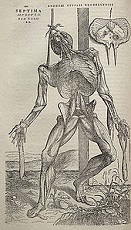



1543 Earl in the year Gustavus I Vasa of Sweden double-crosses the Dacke rebels, and defeats them; Dacke's followers then double-cross and kill him. On Feb. 21 the Battle of Wayna Daga (Amharic for "grape-cultivating altitude") E of Lake Tana in Ethiopia sees 8.5K Ethiopian Christians led by Solomonic emperor (since 1540) Gelawdewos and aided by 70 Portuguese musketeers and 60 cavalry fight 14K infantry and 1.2K cavalry from the Muslim Sultanate of Adal led by imam Ahmad ibn Ibrihim al-Ghazi (b. 1507), who is KIA by a Portuguese musketeer, ending the Ethiopian-Adal War (begun 1529). On Mar. 14 Pope Paul III issues the bull Injunctum Nobis, removing the 1540 membership limitation on the Jesuits. The original Coppertone Baby kept his ass out of the Sun on purpose? On May 24 (May 14 Old Style) (Mon.) Nicolaus Copernicus (Lat. "copper worker") (b. 1473) dies in Frombork, Poland after allegedly awakening from a stroke-induced coma long enough to view the first printed copy of his magnum opus Six Books on the Revolutions of the Celestial Orbits (De Revolutionibus Orbium Coelestium), advancing the Heliocentric Theory (which he had shelved, claiming it to be incomplete or even erroneous, but more likely afraid of Catholic reprisals?), which was pushed through the press by his one and only pupil Georg Joachim Rheticus (Rhaeticus) (von Lauchen) (1514-74) (a Lutheran math prof. whose father had been executed for heresy), and is pub. posth. in safe Protestant Nuremberg; it is (fawningly?) dedicated to Pope Paul III, and incl. a cautious (mendacious?) Preface by Andreas Osiander (1498-1552) of Konigsberg, stating that the revolution of the Earth is a mere mathematical convenience and not necessarily a physical fact (although Coppertone Baby had considered it otherwise?); "There have already been widespread reports about the novel hypotheses of this work, which declares that the Earth moves whereas the Sun is at rest in the center of the Universe. Hence certain scholars, I have no doubt, are deeply offended and believe that the liberal arts, which were established long ago on a sound basis, should not be thrown into confusion. But if these men are willing to examine the matter closely, they will find that the author of this work has done nothing blameworthy. For it is the duty of an astronomer to compose the history of the celestial motions through careful and expert study. Then he must conceive and devise the causes of these motions or hypotheses about them. Since he cannot in any way attain to the true causes, he will adopt whatever suppositions enable the motions to be computed correctly from the principles of geometry for the future as well as for the past. The present author has performed both these duties excellently. For these hypotheses need not be true nor even probable. On the contrary, if they provide a calculus consistent with the observations, that alone is enough. Perhaps there is someone who is so ignorant of geometry and optics that he regards the epicyclc of Venus as probable, or thinks that it is the reason why Venus sometimes precedes and sometimes follows the Sun by forty degrees and even more. Is there anyone who is not aware that from this assumption it necessarily follows that the diameter of the planet at perigee should appear more than four times, and the body of the planet more than sixteen times, as great as at apogee?"; "The massive bulk of the Earth does indeed shrink to insignificance in comparison with the size of the heavens" (Copernicus); the kind of reception awaiting Copernicus' followers is shown right away, when the first Auto da Fe, AKA Act of Faith, or burning alive of heretics (Protestants) by the Spanish Inquisition dressed in weird sinister hoods takes place in the island of Goa in SW India (goa to Hell, you heretics?), and Pope Paul III issues his first Index Librorum Prohibitorum (Index of Prohibited Books); each lucky heretic gets to wear a black sanbenito painted with flames and devils to his own BBQ - toast them marshmallows on a stick, hooray for Christ? On July 1 the Treaty of Greenwich is signed in an attempt to provide peace between Scotland and England for the lifetimes of Henry VIII and 1-y.-o. Mary, Queen of Scots, calling for her marriage to Henry's sickly son Prince Edward (VI). In July the Third Succession to the Crown Act names Henry VIII's heirs as Edward, Mary, and Elizabeth, then the heirs of his younger sister Mary Rose Tudor, Duchess of Suffolk (1496-1533), which incl. Lady Jane Grey; Elizabeth's bastard status is left unchanged. The English game is now parr six? In July Henry VIII (more in need of a nurse than a wife?) marries previously broken-in Catherine Parr (1512-48), his 6th and last wife and the only one other than Anne of Cleves to not get her head parted or cleaved from her body and survive him; the list now incl. Catherine of Aragon, Anne Boleyn, Jane Seymour, Anne of Cleves, Catherine Howard, and Catherine Parr (CAJACC) (3 Catherines, 2 Annes, and 1 Jane); Parr's first hubby was Lord Borough. Turkish adm. Barbarossa II cruises toward Marseille with 210 ships and 30K troops to assist his ally Francis I of France, captures Reggio Calabria, lands on the coasts of Campania and Lazio, threatens Rome from the mouth of Tiber until Francis I intervenes to tell him to cool lit, then satisfies himself with raiding several Italian and Spanish settlements, then sieges Nice, which holds them off a long time but gives up on Aug. 5, after which Barbarossa takes 2.5K captives and pillages the city; he then lands at Antibes and Ile Sainte-Marguerite near Cannes, sacks San Remo, Monaco, and La Turbie, then winters in Toulon while sending occasional ships to bombard Spanish costal cities. On Sept. 9, 1543 Mary Stuart (1542-87) is crowned queen of Scotland in Stirling (until July 24, 1567), becoming known as Mary, Queen of Scots; too bad, within months her betrothal is cancelled by the Scottish Parliament under urging of her pro-Roman Catholic guardians; Henry VIII responds with plans to occupy S and E Scotland in the Rough Wooing, causing Mary to be kept in Stirling for safety, driving Scotland back into the arms of the French; the Scottish Parliament removes the prohibition against vernacular Bibles. On Nov. 1 the U. of Pisa (founded 1343) is officially refounded by Cosimo I de' Medici, who next year founds the Orto Botanico di Pisa, becoming te first univ. botanical garden in Europe. On Dec. 29 the reign of Ivan IV the Terrible (1530-84) in Russia begins when he tells his regents to stuff it and calls his boyars together, then orders boyar leader Prince Shishkabobsky, er, Andrei Shuisky thrown into a pit of starving dogs; the Russian term Grozny actually means Awesome (a term of respect) not Terrible, although he amply lives up to the latter name through his violent unpredictable behavior? - how about Gross? Future Philip II of Spain marries Maria of Portugal. An English army led by Henry Howard fights on the side of HRE Charles V in an effort to acquire the Netherlands. King Sigismund of Poland grants the right of coining money to his vassal the Duke of Prussia, causing the Estates of Poland to pass a decree that that privilege is inseparable from the crown. After getting the Sorbonne pissed-off, Clement Marot flees France for Geneva, followed by Piedmont. Portugal passes a law ordering a search for descendants of Jews so they can be expelled. The first Portuguese land in Japan on Tanegashima Island, introducing firearms to Japan. Juan Rodriguez de Cabrillo (b. 1499) dies of gangrene on Santa Catalina Island, and his pilot Bartolome (Bartolomé) Ferrelo (1499-1550) continues the expedition, exploring the Pacific coast as far as Oregon. Nimjegen, Netherlands-born (St.) Peter Canisius (1521-97) becomes the first German to join the Jesuits, going on to become a leader of the Counter-Reformation. Speaking of Prohibited Books? The Spirituali Movement in Rome, which hopes to reform the Church without splitting like the Protestants pub. the anon. The Benefit of Christ's Death (Beneficio di Cristo), their masterpiece proving that salvation comes through faith in Christ alone, not through works or the Church; after they pub. 40K copies, the Church declares it heretical and places it on the Prohibied Index and starts to come down on them, but Pope Julius III purposely slows down the Inquisition until his death, after which Pope Julius IV lets the dogs loose and exterminates them by the 1560s. Architecture: Clover-leaf-shaped Hurst Castle on Pebble Split in Hampshire (old Wessex) is built by Henry VIII to guard the coast. Inventions: Spanish navigator Blasco da Garay designs a steamboat for HRE Charles V. Nonfiction: Girolamo Cardano (1501-76) (tr.), Euclid's Elements; first trans. into a modern Euro language, correcting errors in the Latin trans obtained from an Arabic source, esp. in Book V, becoming a favorite of Galileo. Petrus Ramus (1515-72), Animadversiones in Dialecticam Aristotetlis (Criticisms of the Aristotelian Dialectic); pisses off the learned doctors of the Sorbonne, who get Francis I to issue an edict to suppress it; Ramus counters by getting a job as pres. of the College de Presles in 1545 - the original Little Richard and Elvis Presley put together? Niccolo Tartaglia (1500-57) (tr.), Euclid's Elements; the first into a modern language (Italian) - collective groan from zillions of schoolboys? Andreas Vesalius (Andre Vesale) of Brussels (1514-64), The Fabric of the Human Body (De Humani Corporis Fabrica) (7 vols.), and the companion vol. Epitome (both in Basel); illustrations by Titian's studio; the first illustrated anatomy of the human body, and the most detailed and extensive to date - is it Science or is it Porno? Martin Luther (1483-1546), On the Jews and Their Lies; calls for their Nazi-like persecution incl. pogroms 400 years before the little-miss-sunshine Nazis, causing their persecution and expulsion from Prague, Worms, Vienna, Genoa, and the papal states over the next 130 years; "A base, whoring people, that is, no people of God, and their boast of lineage, circumcision, and law must be counted as filth"; "Full of the Devil's feces... which they wallow in like swine" (synagogues); "Incorrigible whore and an evil slut". Art: Benvenuto Cellini (1500-71) designs a gold-ivory-enamel Saliera (Saltcellar) for Francis I of France, featuring nude figures of Earth (female) and Sea (male), which becomes his only gold sculpture to survive to modern times; on May 1, 2003 it is stolen from the Kunsthistorisches Museum in Vienna in a smash-and-grab robbery in which the guards miss the event and have no clue as to who did it; 3 years later it is found in a forest N of the city. Lorenzo Lotto (1480-1556), Christ Giving His Blood; Husband and Wife. Il Sodoma (1477-1549), Sacred Conversation (Sacra Conversazione); St. Sebastian with Madonna and Angels. Titian (1477-1576), Ecce Homo. Births: Japanese Tokugawa shogun #1 (1603-16) Tokugawa Ieyasu (Iyeyasu) (Matsudaira Takechiyo) (d. 1616) on Jan. 31 in Mikawa. German Wittelsbach prince (Calvinist) John Casimir, Count Palatinate of Simmern (d. 1592) on Mar. 7 in Simmern; 3rd and youngest son of Elector Palatine Frederick III and Marie of Brandenburg-Kulmbach. English "My Mynde to Me a Kingdome Is" poet-courtier (Rosicrucian?) Sir Edward Dyer (d. 1607) in Oct. in Sharpham Park, Somerset; educated at Balliol College or Pembroke College, Oxford U. English noblewoman Lettice (Laetitia) Knollys (d. 1634) (pr. like knolls) on Nov. 8 in Rotherfield Greys, Oxfordshire; wife (1560-76) of Walter Devereux, 1st earl of Essex (1541-76), (1578-88) Robert Dudley, 1st earl of Leicester (1532-88), and (1589-1601) Sir Christopher Blount (1555-1601); mother of Robert Devereux, 2nd earl of Essex (1565-1601) and Lady Penelope Rich (1563-1607). Italian anatomist and papal physician (to Gregory XIII). Constanzo Varolio (d. 1575) in Bologna. English navigator and buccaneer ("the Queen's Pirate") ("Il Gran Luterano") Sir Francis Drake (d. 1596) in Tavistock, Devon (b. 1549)?; first Englishman to go around and come around the Earth; knighted in 1581 - I don't sweat the small stuff? English novelist-balladist Thomas Deloney (d. 1600). Italian Roman Catholic missionary (to China) Michaele Ruggieri (d. 1607). Swiss architect Domenico Fontana (d. 1607) in Melide (modern-day Ticino), Switzerland (near Lake Lugano); protege of Pope Sixtus V. Scottish judge Sir John Skene, Lord Curriehill (d. 1617). Jewish Qabbala mystic Hayim (Chaim) ben Yosef Vital (d. 1620) in Safed, Palestine; successor of Rabbi Isaac Luria (1534-72). Deaths: Da Man Wid Da Plan Himself? Polish astronomer Nicolaus Copernicus (b. 1473) on May 24 in Frombork (Frauenburg), Warmia (180 mi. N of Warsaw) (stroke); on Nov. 3, 2008 Polish archeologists based in Pultusk in C Poland announce the discovery of his grave under the floor of Frombork Cathedral; on May 22, 2010 Roman Catholic clerics bless his remains with holy water and he is reburied as a hero. German margrave George the Pious (b. 1484) on Dec. 27. German anti-Reformation Catholic theologian Johann Eck (b. 1486). French humanist diplomat Guillaume (William) du Bellay, lord of Langey (b. 1491); dies en route from Turin, Italy to France, with his physician Francois Rabelais present, who eulogizes him in "Garantua and Pantagruel", Bk. III, Ch. 21 and Bk. IV, Ch. 27. Swiss-German composer Ludwig Senfl (b. 1492). Italian poet Agnolo Firenzuolo (b. 1493). Italian painter Polidoro da Caravaggio (b. 1495) (strangled in bed by a workman with a cloth, who is tortured, hung, drawn, and quartered). German Anabaptist leader Melchior Hoffman (b. 1495); dies in prison; leaves writings that influence Menno Simons and David Joris; his followers are called Hoffmanites or Melchiorites. German painter Hans Holbein the Younger (b. 1497). Spanish explorer Juan Rodriguez Cabrillo (b. 1499) on Jan. 3 in Santa Catalina Island (gangrene). German humanist writer Sebastian Franck (b. 1499): "To substitute Scripture for the self-revealing Spirit is to put the dead letter in the place of the living Word."






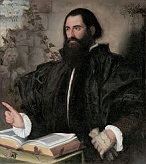

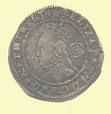
1544 In the spring the Ottomans under adm. Barbarossa II siege San Remo, Italy for a 2nd time, then land at Borghetto Santo Spirito and Ceriale, defeat a Spanish-italian fleet and raid the kingdom of Naples, after which they reach Genoa with 210 ships and demand the release of Ottoman adm. Turgut Reis (Capt. Dragut) (Capt. Darhouth) (1485-1565); after Adm. Andrea Dorea parleys with Barbarossa, he agrees to release him in exchange for 3.5K gold ducats; in May after repulsing Spanish attacks on S France, Barbarossa assaults San Remo a 3rd time, sails to Vado Ligure in N Italy, and takes a bribe to stop further attacks on Genoese cities, then in June arrives in Elba, threatening to bombard Piombini unless the son of Sinan Reis is released, then captures Castiglione della Pescaia, Talamone, and Orbetello in Grossetto, Tuscany, followed by Montiano, Porto Ercole, and Giglio Isle, and sieges Citavecchia until French envoy Leone Strozzi (1515-54) of Florence calls him off; he then assaults Sardinia, lands in Ischia in July, captures Forio and the Isle of Procidia, meets 30 galleys under Giannettino Doria in front of Pozzuoli and chases them away to Messina, then tries to attack Salerno but has to call it off because of strong winds, landing at nearby Cape Palinuro, after which he enters the Strait of Messina and lands at Catona, Fiumara, and Calanna near Reggio Calabria, followed by Cariati and Lipari, bombarding it for 15 days until he captures it; he is then recalled to Istanbul after Sultan Suleiman and HRE Charles V agree to a truce, retiring next year in Istanbul, and dying in 1546 after writing 5-vols. of Memoirs of Hayreddin Pasha ("The Mediterranean Was Ours"). In the summer the Siege of St. Dizier sees the imperial army of HRE Charles V siege St. Dizier on its advance into Champagne, and on July 13 Cahrles V arrives with an army of 14.1K men incl. 1.6K sappers; on July 15 Rene of Chalon (b. 1519) dies in the siege, with Charles V at his bedside, and his 11-y.-o. Lutheran 1st cousin William of Nassau-Dillenburg AKA William I the Silent (Taciturn) (1533-84) becomes prince of Orange (until July 10, 1584), with HRE Charles V as regent, who requires the Lutheran boy to get a Roman Catholic education, which doesn't take; William I founds the House of Orange-Nassau, later leading the Dutch revolt against the Spanish Hapsburgs, becoming "the Father of the Fatherland". On July 19 the Siege of Boulogne in Pas-de-Calais by the English under Henry Howard, earl of Surrey begins, and is joined a few weeks later by Henry VIII, taking the castle on Sept. 18 by digging tunnels under it; Surrey is made cmdr. of its garrison (until 1546); Edward Seymour is promoted from lt.-gen. to capt.-gen.; meanwhile on Sept. 14 the dauphin's army attacks Montreuil, causing the duke of Norfolk to want raise the siege, which is countermanded by Henry VIII on Sept. 18, who leaves for England at the end of Sept., causing 4K English troops to be left to defend the city, while the rest withdraw to Calais, where they are trapped, allowing the dauphin to concentrate on Boulogne, nearly capturing it on Oct. 9; the siege ends in Mar. 1550; meanwhile after invading Picardy, France and running out of ale, the English are forced to drink hopped beer for 10 days; Francis I loses again, and signs the Treaty of Crespy, cementing relations with HRE Charles V by marriage, specifying that Francis I's son the Duke of Orleans (d. 1545) is to marry either Charles V's daughter, with Burgundy (incl. Holland, Belgium and Franche-Comte) as her dowry, or Charles' niece, with Milan as her dowry; in return Francis is to return Savoy and Piedmont to the Duke of Savoy; too bad, the duke of Orleans suddenly dies next year, voiding the treaty; Henry Howard is made field marshal under his father's command, and is wounded at the Siege of Montreuil in the Pas de Calais. The English under Edward Seymour, Duke of Somerset (1506-52) (brother of Jane Seymour) invade Scotland and burn Edinburgh as part of the rough wooing. Newly-appointed royal viceroy Blasco Nunez Vela arrives in Peru (New Castile), only to be expelled to Panama in chains by Gonzalo Pizarro, who claims rulership of Peru, causing him to gather an army for a comeback in 1546. French cardinal David Beaton (1494-1546) becomes co-regent of Mary, Queen of Scots along with her mother Mary. The Succession Parliament meets in Vasteras, Sweden, and the estates agree on several Reformation principles, eliminating Masses, many holy days, holy water, incense, and adoration of the saints. Bishop George Martinuzzi of Grosswardein gets legislation passed in Siebenburgen, Hungary preventing the spread of Protestantism, but co-regent Peter Petrovich gets its enforcement stopped. Duke Albrecht of Hohenzollern decrees that the Polish people of his lands should receive a Polish trans. of the Bible, but takes until 1550 to find a translator. Chungjong dies, and his son Injong II (1515-45) becomes Yi king of Korea (Joseon) (until Aug. 8, 1545). After assisting their brother Gonzalo Jimenez de Quesada in conquering Colombia and founding Bogota, Spanish conquistador Hernan Perez de Quesada (1500-44) and his brother Francisco flee for political reasons, and are killed by lightning while sailing to Cuba; the Colombian natives call it divine retribution for killing the last of the Chibcha kings. The silver mines of Potosi, Bolivia (highest city in the world, alt. 13,420 ft. or 4,090m) are discovered by Diego Huallpa, becoming the most important Peruvian mining center until 1585; the city of Potosi is founded at the foot of the Cerro Rich (rich hill) on Apr. 10, 1545 as Carlos V City; the port of Nombre de Dios in Panama becomes the major port of call for the Spanish treasure fleet, reaching 200K pop. until the rise of Veracruz, Mexico in 1580. The first complete Riksdag since 1530 is assembled in Sweden; the Act of Hereditary Settlement fixes the Swedish succession in the male line; the first truly nat. army in Sweden is established. Inca chief Manco is assassinated in Vilcabamba by seven exiled Almagro partisans who trick him into playing a game of quoits on the plaza then stab him to death for the price on his head; his 9-y.-o. son Titu Cusi is wounded but escapes; Sayri Tupac (-1561) becomes Inca (chief) of what's left of the exiled Incan civilization. Andreas Vesalius becomes physician to HRE Charles V. After 11 years of marriage Catherine de' Medici produces the first of 10 children for King Henri II; all but two of them predecease her; she has four sons, three of whom become kings of France. Pope Paul III calls for a gen. council in Trent in 1545. Diego Garcia, a strategic atoll 1K mi. S of India halfway between Sri Lanka and Mauritius is discovered by Portuguese explorer Diego Garcia de Moguer (1484-1544). Bartolome de las Casas becomes Roman Catholic bishop of Chiapas in S Mexico (until 1547), later returning to Spain, where he writes about his experiences and preaches the Indians' case. Giovanni Pierluigi da Palestrina (1525-94) becomes organist and choirmaster at the main church in Palestrina, SE of Rome (until 1551), where he becomes a favorite of Giovanni del Monte, who becomes Pope Julius III in 1550, and gets him a better gig in Rome. A silver shilling is issued by England which is so debased with copper (two-thirds) that it causes Henry VIII to be given the nickname "Old Coppernose". The U. of Konigsberg is founded by Duke Albrecht I of Prussia, with Copernicus-pushing Lutheran theologian Andreas Osiander as its first prof. in 1549. Architecture: St. Bartholomew's Hospital in London is refounded. Padova, Venice-born architect Andrea Palladio (Andrea di Pietro della Gondola) (1508-80) begins the Palazzo Thiene in Vicenza (finished 1550), introducing the Palladian Architectural Style, which adheres to classical Roman principles that he rediscovered. Science: Georg Hartmann of Germany discovers the Magnetic Dip (Inclination) of the compass. Bolognese physician-botanist Luca Ghini (1490-1556) creates the first known Herbarium (Hortus Siccus) in Pisa, gluing dried plants to cardboard. The cultivation and consumption of the tomato (golden apple) is first described in European lit. in a herbal by Siena, Italy-born physician-botanist Pietro Andrea Gregorio Mattioli (Matthiolus) (1501-77). Nonfiction: Sebastian Munster (1489-1552), Cosmographia Generalis. Michael Stifel (1487-1567), Aritmetica Integra. Matteo Bandello (1485-1562), Il Canzoniere (lyric poetry). Births: French Valois king #11 (1559-60) (hemophiliac?) Francis (Francois) II (d. 1560) on Jan. 19 in Fontainebleau; son of Henri II (1519-59) and Catherine de' Medici (1519-89); husband (1558-60) of Mary Stuart, Queen of Scots (1542-87). Italian "Jerusalem Delivered" poet Torquato Tasso (d. 1595) on Mar. 11 in Sorrento. English electromagnetism scientist (court physician to Elizabeth I and James I) William Gilbert (d. 1603) on May 24 in Colchester; educated at St. John's College, Cambridge U.; first proponent of the Copernican theory in England. German duchess and Dutch princess of Orange (1561-) Anna of Saxony (d. 1577); eldest child of elector Moritz of Saxony and Agnes of Hesse; wife (1561-) of William I the Silent of Orange (1533-84); starts out ugly and hunchbacked, lucks out by inheriting the duchy and marrying a prince, then messes it up by going mad. French Pont Neuf architect Baptiste Androuet du Cerceau (b. 1590); son of Jacques Androuet du Cerceau (1515-84); brother of Jacques II Androuet du Cerceau (-1614). French "Creation du monde" Huguenot divine poet-courtier (Gason Huguenot) Guillaume de Salluste, Sieur Du Bartas (d. 1590) in Monfort. English archbishop of Canterbury (1604-10) Richard Bancroft (d. 1610) in Farnsworth, Lancashire; educated at Christ's College and Jesus College, Cambridge U. Italian "The Reason of State" political philosopher-diplomat-priest Giovanni Botero (d. 1617) in Bene Vagienna. Deaths: Portuguese explorer Diego Garcia de Moguer (b. 1484). French duke of Lorraine (1508-44) Antoine the Good (b. 1489) on June 14. Italian poet Teofilo Folengo (b. 1491) on Dec. 9 in Santa Croce de Campesio (near Bassano). German composer and Protestant cleric Benedictus Ducis (b. 1492). French poet Clement Marot (b. 1496) on Sept. 12 in Turin (exile). Spanish conquistador Hernan Perez de Quesada (b. 1500) in the Caribbean Sea. German physician-botanist Valerius Cordus (b. 1515) on Sept. 25 in Rome, Italy. French prince of Orange (1530-44) Rene of Chalon (b. 1519) on July 15 in Saint-Dizier.






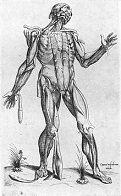

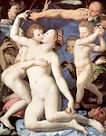


1545 An epidemic begins in Mexico (ends 1550), wiping out 80% of the 15M pop. in five years; salmonella enterica bacterium of the Paratyphi C variety? Francis I vows to invade England to force it to give up its lands in France, and authorizes the first official persecution of the Protestant Huguenots, ordering the Provence Parliament's Arret de Merindol of Nov. 18, 1541 executed in the Massacre of Merindol (Massacre of Mérindol) in Apr. to punish the pesky Waldensians for their religion, with Provencal and Papal soldiers killing hundreds (thousands?). On July 19 Henry VIII travels to Portsmouth and watches from shore as his fleet fights a French fleet of 230 ships; too bad, Henry's favorite ship, the carrack-style Mary Rose (launched July 1511) is sunk in the Solent Straits N of the Isle of Wright, along with vice-adm. Sir George Carew (b. 1504); it is rediscovered in 1971 in the Solent Channel near Portsmouth, and salvaged on Oct. 11, 1982 using airbags, then put in a museum; it sunk because the numerous gun ports were too low and took on water when it tried to turn; the lessons learned cause English ships to be equipped with massive cannonpower, giving them the advantage against the 1588 battle against the Spanish Armada? In Aug. the Treaty (Peace) of Adrianople is agreed to by HRE Charles V, Ferdinand I of Austria, and Sultan Suleiman I the Magnificent, recognizing total Ottoman control of Hungary, plus a yearly tribute of 30K gold florins for their Hapsburg possessions in N and W Hungary; signed in 1547. On Dec. 13 the Council of Trent (19th Ecumenical Council), called by Pope Pius III convenes in Trent in N Italy (until Dec. 4, 1563) to discuss the pesky Reformation started by almost-gone Martin Luther (d. 1546), launching the bloody Counter-Reformation (ends 1648), with Monktown Munich as one of the main bases; three papal legates are sent by Pope Paul III to preside, incl. Cardinal Reginald Pole (1500-58) of England, who is considered next in line for the papacy although he is a secret member of the Spirituali; one good thing, it authorizes Pope Paul III to take up the 1475 work of Pope Sixtus IV and reform the pokey Julian Calendar, and it only takes 37 more years to figure out and implement (1582) - these changes in attitude, changes in attitude, nothing remains the same? On Dec. 24 Henry VIII, who had been seeking to return the English church to a doctrinally Roman Catholic position gives his last speech to Parliament, in which he says that Papist, Anabaptist, and Lutheran are names devised by the Devil to sunder one man's heart from another; meanwhile outspoken Protestant Anne Askew (1521-46) becomes the target of govt. persecution. The Ottomans return, conquer Massawa and occupy the rest of Ethiopia. Moroccan Wattassid sultan (1526-49) Ahmad el Outassi (Abu al-Abbas Ahmad ibn Muhammad) (-1549) is taken POW by the Sharifian Saadians, and Ali Abu Hassun, regent for Ahmad's young son Nasir al-Qasiri pleges allegiance to the Ottomans to obtain their support. Pope Paul III detaches Parma and Piacenza in N Italy (Emilia-Romagna) from the papal states and gives them as a duchy to his illegitimate son (pederast?) Pier-Luigi Farnese (1503-47), whose family rules until 1731, although the duchy lasts until 1860 - and to toss it off, opera conductor Arturo Toscanini is born there in 1867? Pissed-off Mogul emperor Humayun conquers Kabul in Afghanistan. Portuguese naval cmdr. Joao de Castro (1500-48) overthrows Mahmud Shah III, king of Gujarat (Gujerat) in WC India (SW side of the upper lobe, below Punjab and Sind), then relieves the town of Diu and defeats the army of Adil Khan. Nostradamus begins practicing medicine in Marseille. Pope Paul III (who can stop him?), wanting nepotism ("nephew-ism") to get more fame creates 15-y.-o. Ranuccio Farnese (1530-65), son of his illegitimate son Pier-Luigi Farnese as cardinal, causing him to get the nickname cardinalino ("small cardinal)"; not that he turns out that bad, since he backs Italian humanist Federico Commandino (1509-75) in his translation of ancient Greek mathematical works. Ottoman sultan Suleiman the Magnificent appoints Sunni Hanafi legal scholar Mehmed Ebussuud Efendi (1490-1574) as grand mufti (until 1574), who goes on to reorganize the Ottoman legal system to put it more under Sharia, but with the sultan's orders given higher standing; he issues several fatwas, incl. ones permitting consumption of coffee and allowing the performance of Karagoz (Karagöz) (Turk. "black eye") AKA Hacivat (Turk. "Haci Ivaz" = Ivaz the Pilgrim) (shadow) plays, featuring educated refined Turk Hacivat and vulgar illiterate Greek peasant Karagoz, who always gets the better of him with his "native wit". 40-y.-o. U. of Glasgow grad John Knox (1505-72) comes under the influence of religious reformer George Wishart, who is preaching the Lutheran Reformation in Scotland, and becomes a Protestant minister preaching in the castle and parish church of St. Andrews. Pope Paul III invites superstar Titian to visit Rome and gives him a royal welcome, and he begins changing to a free impressionistic style, giving up the red and green predominance in favor of deep yellow and blue. Architecture: Ulm Minster (begun 1377) in Germany is finished, with the highest steeple in the world (161.53m), and a 141m-high viewing platform with 768 steps. Inventions: Claude Garamond (1480-1561) of Paris designs an antique typography. Nonfiction: Roger Ascham (1515-68), Toxophilus or the Schole or Partitions of Shooting; a scholarly defense of archery dedicated to Henry VIII, who grants him a £10 pension. Girolamo Cardano (1501-76), Artis Magnae (The Great Art); treatise on mathematics, containing the solution to the cubic and quintic equations, explaining negative numbers; he had been told the solution to the cubic equation by Niccola Tartaglia in 1535, and had promised not to tell, causing a lifelong war - the origin of "publish or perish" in academia? Benvenuto Cellini (1500-71), Autobiography. Charles Estienne, Anatomy; the first illustrations of venous, arterial, nervous and other physiological systems; describes the valves in the veins, but doesn't explain their function. Jean Fernel (1497-1558), De Vacuandi Ratione. Thomas Geminus (Lambrit) (1510-62), Compendiosa Totius Anatomie Delineatio, Aere Exarata (A Complete Delineation of the Entire Anatomy, Engraved on Copper); shows how cheaper is better, replacing hand-painted illuminations and woodcuts, hastening the spread of know know knowledge. Konrad von Gesner, Biblioteca Universalis (1545-9). Ambroise Pare (1510-90), On Surgery; suggests that wounds be treated with soothing ointments rather than boiling oil. Art: Il Bronzino (1503-72), Venus, Cupid, Folly and Time; given by Cosimo de' Medici to Francis I of France - a conspiracy theorist favorite? Benvenuto Cellini (1500-71), Perseus and Medusa (sculpture) (1545-54) - his magnum opus? Lorenzo Lotto (1480-1556), Apollo Sleeping. Lambert Sustris (1515-84), Perseus and Andromeda. Titian (1477-1576), Portrait of Daughter Lavinia; Portrait of Pietro Aretino; Portrait of Doge Andrea Gritti. Daniele da Voltera (1509-66), Descent from the Cross. Fiction: John Heywood, The Four P's. Births: Italian philosopher-astronomer-mathematician Guidobaldo del Monte, Marquis del Monte (d. 1607) on Jan. 11 in Pesaro; student of Federico Commandino (1509-75); friend of Torquato Tasso and Galileo Galilei: educated at the U. of Padua. English diplomat-scholar Sir Thomas Bodley (d. 1613) on Mar. 2 in Exeter; founder of the Bodleian Library at Oxford U. (1602). Korean #1 adm. Ri Sun Shin (Yi Sun-sin) (d. 1598) on Apr. 28 in Hanyang; friend of Yu Seong-ryong (1542-1607); wins all 22 of his naval battles. English Roman Catholic Jesuit leader Father Robert Persons (Parsons) (d. 1610) on June 24 in Nether Stowey, Somerset; educated at St. Mary's Hall, Oxford U. Spanish prince Don Carlos, Prince of Asturias (d. 1568) on July 8 in Valladolid; eldest son of Philip II and Maria Manuela of Porgugal (daughter of John III); his mental instability causes his father to imprison him in 1568, becoming part of the Black Legend. Scottish theologian-reformer Andrew Melville (d. 1622) on Aug. 1 in Baldovy (near Montrose), Angus; educated at the U. of St. Andrews. Italian duke of Parma and Piacenza #3 (1586-92) Alessandro Farnese (d. 1592) on Aug. 27; gov. of Spanish Netherlands (1578-92); son of Ottavio Farnese (1521-86) and Margaret (illegitimate daughter of HRE Charles V); nephew of Philip II of Spain and Don John of Austria. English king dad Henry Stuart (Stewart), Duke of Albany, Lord Darnley (d. 1567) on Dec. 7 in Temple Newsam, Leeds, Yorkshire; son of Matthew Stewart, 4th Earl of Lennox (1516-71) and Margaret Douglas; 1st cousin and 2nd husband of Mary Stuart, Queen of Scots, by whom he fathers Scottish/English king James VI/I (1566-1625); brother of Charles Stewart, 6th earl of Lennox (-1576). French "Les Juives" playwright Robert Ganier (d. 1590). English herbalist John Gerard (d. 1612) in Nantwich; namesake of the genus Gerardia of figwort plants with showy pink or yellow flowers. French mercantilist economist Barthelemy (Barthélemy) de Laffemas (d. 1612) in Beausemblant (Drome). Spanish novelist-poet Gines Perez de Hita (d. 1619) in Mula (Murcia). Deaths: Spanish historian Antonio de Guevara (b. 1481) on Apr. 3. English soldier Charles Brandon, duke of Suffolk (b. 1484) on Aug. 22 in Guildford. German painter Hans Baldung Grien (b. 1484) in Strasbourg. German Protestant leader George Spalatin (b. 1484) on Jan. 16 in Altenburg. Italian composer Constanzo Festa (b. 1485) on Apr. 10 in Rome; his Te Deum Indian Suri emperor #1 (1538-45) Sher Shah Suri (b. 1486) on May 22 in Kalinjar. is pub. in 1596 and sung in the Vatican on the election of a new pope - te deum or tedium? English composer-organist John Taverner (b. 1490) on Oct. 18 in Boston. German Bavarian duke Louis X (b. 1495) on Apr. 22 in Landshut. English adm. Sir George Carew (b. 1504) on July 19; sunk in the Mary Rose off the Isle of Wight. French noble Charles d'Angouleme, duke of Orleans (b. 1522) on Sept. 9.
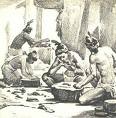









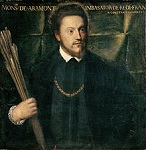
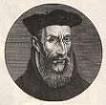


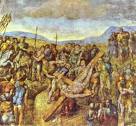
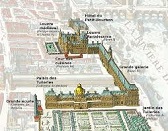


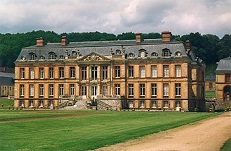
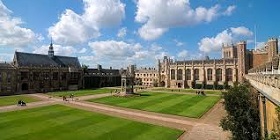

1546 On Jan. 18 the Battle of Anaquito (Añaquito) near Quito sees 700 Spanish conquistador rebels in Peru led by Gonzalo Pizarro defeat 200-300 soldiers loyal to Spanish viceroy of Peru #1 (since May 15, 1544) Blasco Nunez de Vela (b. 1490) at Anaquito, kill him, then parade his head around on a pike, and declare their man Gonzalo Pizarro as gov., causing the Spanish govt., fearing loss of the colony to back down and water down their New Laws protecting indios and restore the encomiendas. On Feb. 18 Martin Luther (b. 1483) dies in his birthplace of Eisleben; Pomeranian Protestant leader Johannes Bugenhagen (1485-1558), whom Luther calls "Doktor Pomeranus" takes care of his widow and children. On Mar. 1 Scottish Calvinist George Wishart (b. 1513) is burned at the stake for heresy in front of St. Andrews; on May 29 St. Andrews is attacked by Wishart's supporters, and Cardinal David Beaton (b. 1494) is killed in revenge. On May 1 after Provence suffers a bad flood which whips up the plague, the city of Aix sends for Nostradamus in Marseille to doctor them, and he achieves spectacular success. Break out those Spanish-English lexicons? On July 16 Protestant martyr Anne Askew (b. 1521), after becoming the first woman tortured (racked) in the Tower is burned at the stake in the last days of Henry VIII at Smithfield. On Sept. 8 Juan de Tolosa discovers silver in El Cerro de la Bufa, founding the town of Zacatecas in La Gran Chichimeca in C Mexico (#2 Spanish silver mine in the New World after Potosi in Bolivia), causing Spanish settlers to flock in from the S and set up mines, with the Spanish crown claiming the quinto (one-fifth of all production); too bad, the proud Chichimecas don't take a shine to them moving in, and aren't pushovers like the Aztecs, beginning the Chichimeca War (ends 1590), the first Spanish frontier war, which proves that Indians can be tough, and takes to the end of the cent. to end - if I were English I'd become a pirate? The Schmalkaldic War (civil war) (ends 1547) begins in Germany between HRE Charles V and the Schmalkaldic League, headed by elector Frederick III the Pious, Johann Frederick the Magnanimous, and Philip of Hesse over the territories of Ernestine Saxony, and Albertine Saxony, which although Lutheran sides with Charles V, who rewards them by forcing the Ernestines to sign their rights to the electorship to them. The Turks occupy Moldavia. After reverses at Saint-Etienne, Henry Howard, earl of Surrey is recalled to England, and in the absence of his old friend the duke of Richmond, along with the loss of influence at court by his daddy Thomas Howard, 3rd duke of Norfolk after the behading of Catherine Howard, his enemies at court frame them both on treasonable ambition charges and get them arrested. Joao de Castro subjugates Malacca for the Portuguese, then next year is made viceroy of the Portuguese Indies. Injong II dies, and Myonjong (d. 1567) becomes Yi king of Korea. The Songhai people destroy the Mali empire in W Africa. The English Navy Board is founded. Roger Ascham becomes language tutor to princess (later queen) Elizabeth (until 1548). Gabriel de Luetz, Baron et Seigneur d'Aramon et de Vallabregues (-1553) is sent by French king Francis I to Constantinople as French ambassador, and is later re-sent by Henry II accompanied by a vast array of scientists incl. Jean de Monluc, Pierre Belon, Pierre Gilles d'Albi, Andrew Thevet, Guillaume Postel, and Nicolas de Nicolay, who later return to France with valuable Ottoman scientific knowledge. Roman bishops at the Council of Trent decide that the Church "venerates equally" the Bible and written and unwritten traditions, thus beginning the Tridentine Church, the modern Roman Catholic Church; the Apocrypha are decreed to be of "equal veneration" with the other books of the Bible, and an anathema is pronounced against all who do not receive them as sacred and canonical; failing to agree whether vernacular translations of the Bible are "the mother and origin of all heresies" or that prohibition would give Protestants ammunition in claiming that the Church is attempting to hide "fraud and deceit", the Latin Vulgate trans. is sanctioned as the standard text for the Church, stifling vernacular translations by default - if it makes you happy then why the hell are you so sad? Spain's "New Laws" (1542) barring enslavement of Indians are repealed at the insistence of New World colonists; meanwhile the brutality of the German Welsers in Venezuela, combined with protests in Spain against granting land to "foreigners" causes the crown to revoke their concession and send Spanish troops to conquer Venezuela (finished 1556), which an Indian confederation resists for 10 years until smallpox softens them up for the kill. Pedro de Valdivia penetrates into S Chile, fighting the hostile Mapuches. After Mayan slaves, led by native priests revolt against their encomiendas in E Yucatan, the Spanish and their Catholic traitor Mayan allies finish conquering Yucatan, founding Valladolid (in modern-day Morelia) and Salamanca de Bacalar, and enslaving Mayans and distributing them to encomiendas, where they are treated like, er, shit, while Yucatan's first Roman Catholic bishop, Franciscan monk Diego de Landa Calderon (Calderón) (1524-79) burns all of the Mayan books he can find, uttering the soundbyte: "They contain nothing but the lies of the Devil", finally being recalled to Spain for overzealousness; only the area of Peten (Petén) in modern-day N Guatemala and Campeche, SE Mexico remains unconquered (until 1700). Pedro de Alvarado arrives with 500 men to seize land from Sebastian de Belalcazar, claiming that it had not been part of the grant made to Pizarro, but Pizarro's men cause him to abandon his claims and turn back in exchange for a large indemnity; too bad, Belalcazar orders the execution of neighboring province gov. Jorge Robledo, and gets convicted and condemned to death in absentia in Spain for murder in 1550, then dies in 1551 on his voyage to Spain to appeal the verdict. The fortune of the Fuggers of Augsburg is valued at 4M guldens (golden florins) (guilders). Henry VIII founds Trinity College at Cambridge U., which goes onto become the largest Oxbridge college; grads later incl. Isaac Newton, Thomas Babington Macaulay, Adam Sedgwick, Lord Byron, Alfred Lord Tennyson, Bertand Russell, James Clerk Maxwell, Ernest Rutherford, Niels Bohr, and Ludwig Wittgenstein; in 1599-1608 a fountain is built in the Great Court. Cardinal College at Oxford U. (founded 1525) is refounded as Christ Church, becoming one of the two most aristocratic colleges in Oxbridge along with Trinity College, Cambridge U.; its college chapel is Christ Church Cathedral; it goes on to produce a record 13 British PMs. Corpus Christi College is founded at Oxford U. Michelangelo is appointed by Pope Paul III as unsalaried supervising architect of St. Peter's Basilica,, which was left unfinished by Pope Julius II; he designs the dome and undertakes to complete the whole thing, producing his first model in 1547. French architect Pierre Lescot (1510-78) begins the construction of the SW wing of the Louvre Palace on the right bank of the Seine River in Paris on the site of a 13th cent. (Philip II) castle, introducing the 4-sided gambrel-style Mansard (French) (Curb) Roof, which is later popularized by French architect François Mansart (1598-1666); it eventually forms a square of 576 ft. by 538 ft. between the Tuileries Gardens and the Church of Saint-Germain l'Auxerrois; in 1793 part of is turned into a public museum. Science: Flemish cartographer Gerardus (Gerhardus) Mercator (1512-94) (Lat. "merchant") states that the Earth has a magnetic pole. Nonfiction: Anon., Yny Lhyvyr Mwnn; the first Welsh book. The original polymath with feet in two worlds? Leo Africanus (Al-Hasan al-Wazzan) (Yuhanna al-Asa), AKA John/Johannes/Giovanni and/or Leo/Leone the Lion (1488-1554), History and Description (Cosmography and Geography) of Africa; Granada-born Fez-raised traveler-diplomat meets Sultan Selim, is seized by Christian pirates in the Mediterranean, held as a prisoner in Rome with access to the papal library, meets with Pope Leo X, is baptized a Christian to get freed, and is given the surname "de Medici" by the pope, becoming a big dude in Rome, writing five books and meeting with Francois Rabelais before returning to Tunis and reverting to Islam; he describes Timbuktu as a city of gold where the emperor eats off half-ton golden platters, causing Euro explorers to become obsessed with finding it, although it had been lost after the Niger River was swallowed up by the Sahara Desert? Georgius Agricola (1494-1555), De Natura Fossilium; first attempt to categorize rocks, minerals, and sediments since Pliny's "Natural History; in their 1912 English tr., Herbert and Lou Hoover wrongly claim that he coined and first used the term "petroleum" (Lat. "rock oil") here. Etienne de la Boetie, Le Discours de la Servitude Volontaire. Valerius Cordus, Pharmacopoeia; first ever by a Euro? Girolamo Fracastoro (1478-1553), On Contagion (De Contagione et Contagiosis Morbis et Eorum Curatione) (3 vols.); the first discussion of contagious infections, suggesting that diseases like syphilis, rabies, and phthisis are like seeds, which he calls (Fomes (Lat. "tinder") that can be transferred from person to person as they "propagate their like" through air, water, etc. via direct contact, indirect contact, or at a distance; "By fomes I mean clothes, wooden objects, and things of that sort, which though not themselves corrupted can, nevertheless, preserve the original germs of the contagion and infect by means of these"; he becomes the first to recognize the disease typhus. John Heywood (1497-1580), The Proverbs of John Heywood; incl. the line "The Moon is made of a greene cheese". Art: Il Bronzino (1503-72), Eleanor of Toledo; wears the cursed Medici pearls; her tomb is opened in 1982, and she is found to be buried in the same dress, sans the pearls? Giulio Clovio 1498-1578, The Farnese Hours; illuminated ms. containing 28 miniatures of Old and New Testament scenes, created for Cardinal Alessandro Farnese; his masterpiece; incl. The Corpus Christi Procession in Rome, Adam and Eve. Lucas Cranach the Elder (1472-1553), Portrait of Martin Luther. Michelangelo (1475-1564), The Crucifixion of St. Peter (1546-60); fresco in the Pauline Chapel in the Vatican. Titian (1477-1576), Pope Paul III and His Nephews; shows him as sharp and hawk-eyed. Novels: Francois Rabelais (1494-1553), Pantagruel, Pt. 3. Plays: Pietro Aretino (1492-1556), Orazia. Hans Sachs (1494-1576), Lisabetha. Poetry: Luigi Alamanni (1495-1556), La Coltivazione; long Vergil-style Georgics clone. Births: Ottoman sultan #12 (1574-95) Murad (Murat) III (d. 1595) on July 4 in Manisa; eldest son of Selim II the Sot (1566-74) and Nur-Banu (Cecilia Venier Baffo) (1525-83); father of Mehmed III (1566-1603). Danish astronomer Tyge Ottesen "Tycho" Brahe (d. 1601) (pr. TOO-koh BRA-huh) on Dec. 14 in Knudstrup Castle, Skane, S Sweden; collaborator of Johannes Kepler (1571-1630). English astronomer Thomas Digges (d. 1595) in Wotton, Kent; son of Leonard Digges (1520-59). Dutch Mannerist sculptor Adriaen de Vries (d. 1626) in The Hague. Deaths: Italian painter Gaudenzio Ferrari (b. 1471) on Jan. 11. Turkish #1 adm. Barbarossa II Hayreddin Pasha (b. 1478) on July 4 in Istanbul; his mausoleum in Barbarossa Park features the immortal lines by poet Yahyah Kemal Beyatli: "Whence on the sea's horizon comes that roar?/ Can it be Barbarossa now returning/ From Tunis or Algiers or from the Isles?/ Two hundred vessels ride upon the waves,/ Coming from lands the rising Crescent lights;/ O blessed ships, from what seas are ye come?"; Turkish seamen begin saluting his mausoleum with a cannon shot before leaving for naval ops. German Protestant Reformation firestarter Martin Luther (b. 1483) on Feb. 18 in Eisleben, Saxony: "Whoever drinks beer, he is quick to sleep; whoever sleeps long, does not sin; whoever does not sin, enters Heaven! Thus, let us drink beer!" Italian architect Antonio da Sangallo the Younger (b. 1484) on Aug. 3. German Lutheran theologian Friedrich Myconius (b. 1490) on Apr. 7. Spanish viceroy of Peru #1 (1544-6) Blasco Nunez de Vela (b. 1490) on Jan. 18 in Anaquito (KIA). Italian painter-architect Giulio Romano (b. 1492). Scottish cardinal David Beaton (b. 1494) on May 29 in St. Andrews Castle, (murdered). English writer Sir Thomas Elyot (b. 1499). English Protestant martyr Anne Askew (b. 1521) on July 16 in London (burned at the stake).
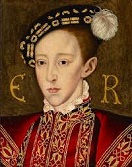


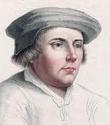





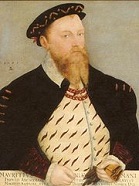




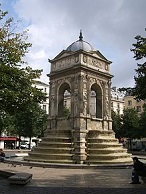
1547 Moscow is destroyed by fire. On Jan. 2 the unsuccessful conspiracy of Gianluigi (Giovanni Luigi) Fiesco (Fieschi) (1522-47) against easy-to-hate 80-y.-o. (but still strong) imperial adm. Andrea Doria rocks Genoa. On Jan. 16 17-y.-o. Ivan IV Vasilyevich the Terrible (1530-84) is crowned the first official "tsar (czar) [Caesar] of all the Russias" (until Mar. 28, 1584), going on to centralize, reform, and expand the Russian state until he goes off the deep end in 1560. The Seymours see more ups and downs than a roller coaster, but how 'bout them Howards? On Jan. 28 bloated bloody tyrant (since Apr. 22, 1509) Henry VIII (b. 1491) of England (who saw it all, Columbus, Copernicus, Luther, etc.) dies in London (of syphilis?), with archbishop Thomas Cranmer at his side, after 72K are executed during his reign, incl. by burning at the stake, boiling alive, hanging and decapitation, leaving some memorable poetry (although no legitimate grandchildren, not that he didn't try?), and is succeeded by his sickly 9-y.-o. son (by Jane Seymour) (was it aged spermatozoa?) Edward VI (1537-53) (Britain's 41st monarch) (until July 6, 1553), with his uncle Edward Seymour, 1st Duke of Somerset (1506-52) appointed lord protector of the realm (until 1549) by the royal council and created 1st duke of Somerset on Feb. 15; Henry's will names Thomas Cranmer as one of the regents; Catherine Parr survives him by less than two years, and Anne of Cleves by 10; "King Henry VII, to six wives he was wedded, one died, one survived, two divorced, two beheaded" (CAJACC); Henry Howard, 1st earl of Surrey is executed for treason, and his father Thomas Howard, duke of Norfolk signs a confession of complicity and is scheduled for execution in Norfolk, but his neck is saved by the death of the king, causing him to be imprisoned in the Tower of London; Sir Richard Rich (1496-1560) becomes executor of Henry VIII's will, and next Feb. 26 is created baron Rich of Leez, then in Mar. becomes lord chancellor; Greek geek Sir John Cheke (Cheek) (1514-57) becomes Edward's tutor, although after his daddy's personal example nobody can stop him from believing that the king has a divine right to rule and to control the nat. church, writing at age 12 (1549) that the pope is the "true son of the devil, a bad man, and the Antichrist", and seeking to establish Protestantism. In Feb. Strasbourg surrenders to the troops of HRE Charles V, after which Jacob Sturm von Sturmeck obtains favorable terms. It's no time for a moondance, my love? On Mar. 31 king (since 1515) Francis I (b. 1494) dies of syphilis, and his son the duke of Orleans is crowned Henri (Henry) II (1519-59), Roman Catholic Valois king #10 of France (until 1559); Catherine de' Medici (1519-89) becomes queen consort (until 1559), going on to have three weak sons that she dominates - yah, it's good to be in control? On Apr. 10 the Spanish govt. appoints bishop Pedro de la Gasca (1485-1567) as its 2nd viceroy of Peru (until Jan. 27, 1550), with unlimited powers to kick rebel conquistador butt, but when he arrives he first tries to win them over with a conciliatory policy. On Apr. 22 the Battle of Bungo in Japan sees the Mori clan eliminate the bungling Shimazu clan as a rival for the shogunate. On Apr. 24 after Protestant elector John Frederick I the Magnanimous (1503-54) of Saxony marches his army S to fight the pesky Roman Catholics, and is invaded by his Catholic cousin Duke Maurice I (1521-53) (Catholic father and Protestant mother), then returns quickly to repel him, HRE Charles V's armies, commanded by up-and-coming Spanish noble gen. Fernando Alvarez de Toledo, Duke of Alva (Alba) (1508-82) rush N, surprise and brilliantly defeat him at the Battle of Muhlberg (Mühlberg), taking Magnum P.I. POW, becoming the final battle in Charles V's campaign to rid the HRE of pesky Lutheranism, ending the Schmalkaldic War (begun 1546); he then sieges Magnanimous' pretty and fecund wife Sybille of Cleves (1512-54) and her three sons in the town where it all started Wittenberg, forcing him to protect them (it?) (himself?) by signing the Capitulation of Wittenberg, resigning the town and his electorship as head of the Ernestine line of the house of Wettin to Maurice, head of the rival Albertine line (which lost it in 1485); after his death sentence is reduced to life in priz, Magnanimous earns his nickname by refusing to give up the Protestant faith or acknowledge the Augsburg Interim for a quick release, uttering the soundbyte that it would be "a sin against the Holy Ghost, because in many articles it was against the Word of God"; meanwhile the Albertine court in Dresden replaces Wittenberg as the capital of Saxony, causing it to decline; the big D causes many Lutheran princes and key reformers incl. Martin Bucer to flee to England, where they influence the English Reformation - the Saxons always did like to do things strong or not at all? In Apr. brand-new Protestant John Knox (1513-72) has his first public debate with papists in St. Andrews; on July 30 St. Andrews is retaken by a French fleet, and Knox spends 19 mo. in French galleys (until 1549). On Sept. 10 Pier-Luigi Farnese (b. 1503) is murdered in Piacenza by Parmesan nobles, causing imperial troops to be sent to occupy Piacenza, and his 2nd son Ottavio Farnese (1521-86) to not succeed as duke #2 of Parma and Piacenza until 1556 because his grandpa Pope Paul III claims them for himself, giving him boring old Camerino instead, which pisses him off, causing him to go to Ferrante Gonzaga for aid, hastening the pope's death in 1549. On Sept. 10 ("Black Saturday") Edward Seymour, 1st Duke of Somerset (1500-52) continues with the "rough wooing" by leading 17K English troops (incl. German and Spanish mercenaries) on 30 warships into Scotland and winning the Battle of Pinkie Cleugh near Musselburgh (double entendre?), becoming the first modern battle fought in the British Isles and the last to be fought between the Scottish and the English royal armies (also first time the English use naval artillery in a land battle in Britain), killing 5K of 23K-36K Scottish troops and taking 1.5K POWs, vs. only 500 English KIA; the day before stupid Scot leader the Earl of Home took his 1.5K horsemen into battle at Fawside (Fa'side) (Faside) Castle, losing most of his cavalry, after which it is burned down, killing all inside; Edward Seymour's men then lay waste to SE Scotland, causing crowds of fugitives to flee to Dalkeith, while being cut down by the stankin' English on the way, making Edward a bigger man than ever; Mary Stewart is secretly moved to remote Inchmahome Priory; a large timber-earthwork fort is built on the site of ruined Roxburgh Castle on the Scottish border; meanwhile Edward's brother lord high adm. Thomas Seymour, 1st Baron Seymour of Sudeley (1508-49) wastes no time movin' on up, marrying dowager queen Catherine Parr; the French offer to help too late, causing grumbling, and then Francis, 2nd duke of Guise, Mary Stuart's uncle, who dominates the king makes him demand her marriage to the infant dauphin Francis as a condition; meanwhile Thomas Seymour romps in the garden with their guest (Catherine's stepdaughter) princess (future queen) Elizabeth, cutting her gown into 100 pieces in the garden while Parr holds her, and later visiting her bedroom. Edward VI repeals De Heretico Comburendo, the 1401 act of Parliament providing for the burning of heretics; too bad, his successor Bloody Mary I restores it. The crown of Bohemia is proclaimed hereditary in the house of Hapsburg. A poor rate is levied in London; Bedlam Hospital is acquired by the City of London, operating until 1948. New Spain viceroy Antonio Hurtado de Mendoza convenes an ecclesiastical conference attended by Bartolome de las Casas, and passes regulations requiring Indian slave laborers to be paid, fixing the max number of hours they can work, and protecting Indians lands from exploitation - Curb Cereal's new crunch is different? After Francis I dies, a reaction against free thought begins in France, causing Francois Rabelais to flee to Metz then Rome, but Cardinal de Lorraine works his return, and gets him the living of Meudon, where he spends the rest of his life; French supersedes Latin as the official language of French authorities; meanwhile PC-challenged Nostradamus moves to Salon, likes it and decides to live there for the rest of his life, but first he is called to Lyons to cure another pestilence (whooping cough?), returning by Nov., and marrying rich widow Anne Ponsart Gemelle, then settling down on the Place de la Poisonniere, where he goes into regular trances, and in 1554 begins writing his Centuries (1st ed. 1555), consisting of 100 prophetic quatrains in several languages (French, Provencal, Italian, Greek, Latin) in each of 10 vols. (vol. 7 is never completed, and vols. 11-12 are planned but left unfinished at his death); Beaune mayor Jean Aymes de Chavigny quits his job to study under Nostradamus (1503-66), later editing the first complete ed. of the Centuries. In 1547-9 after being hired to redesign the future Lescot wing of the Palais du Louvre, the French Renaissance (recycled Italian Modernism) Fontaine des Innocents (Nymphes) is built in Paris by architect Pierre Lescot (1515-78) and sculptor Jean Goujon (1510-68) to celebrate the royal entry of Henry II, becoming the earliest monumental fountain in Paris; they go on to collaborate on the Louvre and the Church of St. Germain l'Auxerrois in Paris (until 1562). The first written mention of the Guinea pig in Santo Domingo, Hispaniola. A free-roaming sow and her six piglets are tried for eating a child, and the sow is executed, but her piglets are spared because of their youth and the bad example of their mother? Architecture: Palais Granvelle in Besancon, France (begun 1534) is finished. Nonfiction: Thomas Cranmer et al., Homilies. De Mysteriis Egyptorum (Lyons); later used by Nostradamus (1503-66), who quotes from it in his prophecies, which begin this year. William Baldwin (1515-63), A Treatise of Morall Phylosophie. Louis Bourgeois (1510-65), Psalter. Henricus Glareanus (1488-1563), Dodekachordon (Basel); on the 12 church modes; source of duos. Christopher Langton, A Very Brefe Treatise, Ordrely Declaring the Principal Partes of Phisick (London); contains a sonnet by William Baldwin, becoming the first pub. English sonnet? William Salesbury (1520-1600), Dictionary in Englyshe and Welshe. Poetry: Giangiorgio Trissino, L'Italia Liberata dai Goti (epic poem). Births: Spanish gen. (hero of the 1571 Battle of Lepanto) Don John (Juan) of Austria (d. 1578) on Feb. 24 in Regensburg, Bavaria; illegitimate son of HRE Charles V by Barbara Blomberg (1527-97); half-brother of HRE Philip II of Spain; taken to Valladolid, Spain at age 3 and brought up under the name Geronimo - which came first, the Spic or the Apache? German scholastic philosopher (coiner of the term "psychology") Rudolph (Rudolf) Goclenius (Gockel) (Göckel) the Elder (d. 1628) on Mar. 1 in Korbach, Waldeck (Waldeck-Frankenburg, Hesse). German landgrave George I of Hesse-Darmstadt (d. 1596) on Sept. 10 in Cassel. Spanish "Don Quixote" novelist ("the Cripple of Lepanto") Miguel de Cervantes Saavedra (d. 1616) on Sept. 29 in Alcala de Henares. German writer Johann Fischart (d. 1590). Dutch navigator-explorer Willem Barents (Barentsz) (d. 1597) in Terschelling, West Frisian Islands. Italian printer Aldus Manutius the Younger (d. 1597). Spanish novelist Mateo Aleman (d. 1615) in Seville. English Anglican bishop of Winchester (1597-) Thomas Bilson (d. 1616) in Winchester. American Pawmunkey (Chesapeake Bay area) Indian chief Powhatan (Wahunsonacock) (d. 1618); father of Pocahontas (1595-1617); brother of Opechancanough (-1644); "Such a grave and Majesticall countenance, as drave me into admiration to see such a state in a naked Salvage" (Capt. John Smith). English portraitist (miniaturist) Nicholas Hilliard (d. 1619). Polish gen. Stanislaw Zolkiewski (d. 1620) in Turynka (near Lwow). Deaths: Italian bembist poet-cardinal Pietro Bembo (b. 1470) on Jan. 18 in Rome. Spanish conquistador Hernando Cortes (b. 1485); conquered 315K sq. mi. from the Aztecs in C and S Mexico, as well as Guatemala and Honduras. Italian painter Sebastiano del Piombo (b. 1485). Italian poet Vittoria Colonna (b. 1490) on Feb. 25. English king (1509-47) Henry VIII (b. 1491) on Jan. 28 in Whitehall Palace, London (diabetes?) (syphilis?); he suffered from McLeod Syndrome and/or Kell Antigens in his blood? French king (1515-47) Francis I (b. 1494) on Mar. 31 in Chateau de Rambouillet (syphilis). English historian Edward Halle (b. 1497). Italian duke #1 of Parma (1545-7) Pier Luigi Farnese (b. 1503) on Sept. 10 in Piacenza; stabbed to death by Count Francesco Anguissola et al. and hung from a window of his palace. English poet-soldier Henry Howard, earl of Surrey (b. 1517) (beheaded for high treason); his trans. of two books of Vergil's "Aeneid" gives the English language blank verse and the sonnet (three quatrains and a couplet).

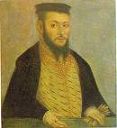



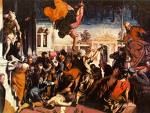
1548 The number of Caribbean (from the word cannibal) aborigines has fallen from 1M in 1492 to less than 1K (about 500); African slaves are now brought in to work the mines and fields. On Apr. 1 Sigismund (Zygmunt) I Stary (b. 1467) dies, and his only son Sigismund II Augustus (1520-72) becomes king of Poland and grand duke of Lithuania (until July 7, 1572), the last of the Jagiellonian Dynasty (founded 1386), facing the spread of the Protestant Reformation. On Apr. 9 after Pedro de Valdivia returns from Chile to Peru to support viceroy Pedro de la Gasca, Francisco Pizarro's son Gonzalo Pizarro is defeated at the Battle of Xaquixaguana (Jaquijahuana), then executed; even though La Gasca redistributes some encomiendas, some conquistadors remain discontented. Since I got in the loop I can see the future? On May 15 HRE Charles V decrees the Interim of Augsburg, an attempt to define a brand of Roman Catholicism acceptable to Lutherans without offending er, real Catholics too much, and the Augsburg Diet adopts it on June 30; Maurice of Saxony modifies it into the Interim of Leipzig. On Aug. 7 after Parliament accepts the terms of marriage between 5-y.-o. Mary Stuart, Queen of Scots and 1-mo.-younger dauphin Francis (Francois), she is sent to France by the west route for her safety with the "Four Marys" (Scottish noblewomen Mary Beaton, Mary Fleming, Mary Livingston, Mary Seton) (mother Mary of Guise remains in Scotland), and arrives in Roscoff, France on Aug. 13, living in France with the royal family for 13 years (until 1561), with governess Madame de Parois, and becoming friends with Francis' sister Princess Elisabeth; she soon forgets her native Scottish tongue and learns French, which she sticks with for life, is brought up as a good Catholic, and grows to 6 ft. tall; too bad, while Elisabeth is given a first class education incl. Machiavelli's "The Prince", Mary is regarded as just a dauphiness and not taught govt. admin. or politics, which messes her up later, although she becomes a good musician and poet - and never, never wears mens' clothes in public? On Sept. 5 Henry VIII's 6th and last wife Catherine Parr (b. 1512) dies six days after giving birth to her only child, Mary Seymour (1548-51) on Aug. 30; Thomas Seymour is beheaded next Mar. 20 for treason, after which Mary is disinherited and soon dies; in 1782 John Locust discovers Catherine's coffin in Sudeley Castle and opens it, finding the body in good condition and the flesh on an arm still white and moist?; when it is reopened in 1817 only a skeleton remains. On Oct. 20 the city of La Paz (La Ciudad de Nuestra Senora de La Paz) (The City of Our Lady of Peace) in W Bolivia (modern-day pop. 877K/2.3M) is founded by Spanish conquistadors on the site of an earlier settlement. The Turks occupy Tabriz, Persia. A revolt by the Zapotecs in the Oaxaca Valley in SE Mexico is suppressed, and Father Juan Lopen Zarate introduces sheep's wool to supplant their cotton weaving. A Spanish audiencia is established for El Nuevo Reino de Galicia (Nueva Galicia), with Guadalajara as the capital. The coastal town of Borburata in Venezuela is founded, becoming the scene of numerous pirate raids through the 17th cent. The town of Helsinki (Helsingfors) (originally Helsinge fors or Helsinge Rapids) in S Finland on the shore of the Gulf of Finland (modern-day pop. 642K/1.47M) is founded in Finland is founded in Forsby Village, and chartered by Gustav I of Sweden as a trading town to rival the Hanseatic city of Reval (Tallinn), which turns out to be a dud; in 1710 a plague almost wipes out the pop.; in 1809 after Russia annexes it as the autonomous Grand Duchy of Finland it begins a resurgence, becoming known as "the Daughter of the Baltic"; in 1812 Russian Tsar Alexander I moves the capital of Finland there to reduce Swedish influence and bring it closer to St. Petersburg. Rich merchant Thomas Gresham founds seven professorships in London; the U. of London is not founded until 1828. The U. of Messina is founded in Messina, Italy by St. Ignatius of Loyola, becoming the first Jesuit college. The U. of Jena is founded in Jena, Thuringia, Germany as an academy by the three sons of Elector John Frederick of Saxony, gainting a charter from HRE Ferdinand I on Feb. 2, 1558. Miles Coverdale returns to England, is appointed chaplain to Edward VI, then begins a career as a popular preacher. Dutch portraitist Sir Antonis Mor (1520-76) is discovered by Bishop Grenville, who presents him to HRE Charles V, after which he goes on to do portraits of all the Euro Catholics of the day, starting with Philip II next year. Titan is called to Augsburg to paint more portraits of HRE Charles V and other nobles. The guinea pepper plant is first grown in England. Architecture: The Hotel de Bourgogne in Paris is built by the Confrerie de la Passion to stage religious dramas, becoming the first roofed theater in Paris; too bad, in 1551 a royal edict forbids the performance of "mysteres" in Paris, but the Confrerie is granted a monopoly over the public performance of other types of drama, causing any troupe wishing to perform in the city to have to rent their hotel (until 1634). The Renaissance Chateau de Vallery in Yonne, Burgundy, designed by Pierre Lescot (1510-78) is built for Marechal Jacques d'Albon de Saint-Andre (Saint-André), court favorite of Henri II. Nonfiction: Anon., The Order of the Communion; first communion service in English. Michael Agricola (1510-57), Se Wsi Testamenti (Stockholm); the New Testament in Turku Finnish. John Bale (1495-1563), Illustrium Majoris Britanniae Scriptorum, hoc est, Angliae, Cambriae, ac Scotiae Summarium (Summary of the Famous Writers of Great Britain, that is, of England, Wales, and Scotland); 2nd ed. pub. in 1557-9; chronological catalog of British authors and their works. Desiderius Erasmus (1466-1536), The First Tome or Volume of the Paraphrase of Erasmus Upon the New Testament (Jan.) (posth.); ed. by Nicholas Udall; pub. by Edward Whitchurch; Erasmus' trans. of the New Testament interleaved with an English trans.; vol. 2 pub. in 1549; a royal injunction orders copies to be kept in every parish church in England. Jean Fernel (1497-1558), De Abditis Rerum Causis. St. Ignatius of Loyola (1491-1556), Spiritual Exercises (written in 1522-4) (pub. after being papally sanctioned); becomes a Roman Catholic hit - takes several weeks but when you're through you're clear like Tom Cruise? Cavalier Cipriano Piccolpasso, Li Tre Dell' Arte Del Vasi (3 vols.); first Euro work on the art of pottery. Art: Tintoretto (1518-94), St. Mark Rescuing a Slave (Miracle of the Slave); his first masterpiece; uses foreshortening, and makes small wax models on a stage with spotlights, with the motto "The drawing of Michelangelo and the color of Titian". Titian (1477-1576), HRE Charles V on Horseback at the Battle of Muhlberg (Mühlberg). Poetry: Theodore Beza (1519-1605), Juvenialia; makes him a celeb.; incl. "De Sua in Candidam et Audebertum Benevolentia", saying that although he has kissed both Audebert and Candida, he loves Candida most, causing later allegations of pederasty by Catholics; after pub. the book he gets sick, converts to Protestantism and moves to Geneva on Oct. 23, 1548. Births: Italian architect Vincenzo Scamozzi (d. 1616) on Sept. 2 in Vicenza; teacher of Baldassarre Longhena (1598-1682). Italian superstar Neoplatonist philosopher Giordano Bruno (d. 1600) in Nola, Campania (kingdom of Naples); starts out as a priest in 1572, is caught defending Arianism and Erasmus in 1576, and takes a long hike. Spanish Roman school church composer Tomas Luis de Victoria (Tommaso Ludovica da Vittoria) (d. 1611) in Avila, Castile; lives in Madrid from 1589-1611. Spanish Jesuit anti-divine-right-of-kings scholastic philosopher Francisco Suarez (d. 1617); writes in Latin; argues that kings derive their authority from the people and not directly from God, and may thus be deposed - he wants to bite the hand that feeds him? Dutch mathematician-engineer Simon Stevin (Stevinus) (d. 1620) in Bruges? Spanish soldier Sebastian Vizcaino (Sebastián Vizcaíno) (d. 1624) in Extremadura, Castile. Italian painter Jacopo Negreti (Palma Giovane) (Palma the Younger) (d. 1628) (b. 1550?); grandnephew of Palma Vecchio (1480-1528); pupil of Titian (1477-1576), and heir to the Venetian School after he and Veronese die, presiding over its slide toward decadence. English soldier Sir William Stanley (d. 1630) in Hooton. English poet Isabella Whitney (d. ?); first English woman to pub. a book of poetry. Deaths: Polish king (1506-48) Sigismund I the Old (b. 1467) on Apr. 1 in Cracow. Spanish explorer Pascual de Andagoya (b. 1495) on July 18 in Cuzco. Italian scholar Agostino Steuco (b. 1497) in Venice; leaves De Perenni Philosophia, dedicated to Pope Paul III, coining the term "Perenni Philosophia" (Perennial Philosophy) for the single universal truth shared by all world religions. Portuguese naval officer Joao de Castro (b. 1500). German duke Philip the Contentious of Palatinate-Neuburg (b. 1503) on July 4 in Heidelberg. English queen Catherine Parr (b. 1512) on Sept. 5 in Sudeley Castle, Gloucestershire. Mexican Roman Catholic saint Juan Diego on May 30.
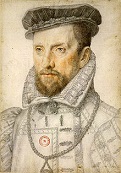




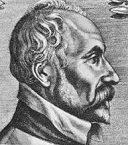



1549 On Mar. 20 Jane Seymour's elder brother Thomas Seymour, 1st baron Seymour of Sudeley (b. 1508), lord high adm. of the British fleet is executed for treason for messing with princess Elizabeth then attempting a coup, breaking into Edward VI's apts. at Hampton Court Palace on the night of Jan. 16 armed with a sword, and being given away by a pet spaniel, which he kills; his brother Edward Seymour is imprisoned in the Tower, and replaced as lord protector by John Dudley, Viscount Lisle, Earl of Warwick, Duke of Northumberland (1502-53); the scandal almost takes Elizabeth down until they can't prove enough hanky-panky in court to execute a royal heir, giving her a quick education in power politics and helping her become a tough survivor who trusts nobody. In Mar. John Knox is released from the French galleys after 19 mo. at the intercession of Edward VI, and goes to England, where he is appointed to the reformed Church of England at Berwick; with his help, the first Book of Common Prayer is introduced by Archbishop of Canterbury Thomas Cranmer (1489-1556) on the Day of Pentecost, along with the First Act of Uniformity (2nd 1552) (backed by Edward Seymour, passed by a close 10-8 vote of the bishops), banning all Latin-language Roman Catholic missals and liturgical books, and requiring the use of the Book of Common Prayer starting on May 20, emphasizing the peoples' participation in the Eucharist, and requiring the Bible to be read in English from cover to cover, sparking the Prayer Book Rebellion in Cornwall and Devon by 7K, causing 8.6K English troops incl. German and Italian mercenaries to be brought in by Edward VI, massacring 2K+; the Prayer Book prints special holy days in red ink, causing the term "red letter day" to become popular, although the Roman Catholic Church was already doing it (they call it rubrics) - you better not mess with Major Tom? In May a major night attack on English-held Boulogne by the French under Gaspard II de Coligny, Seigneur de Chatillon (1519-72) is repulsed, with 200 French KIA. On Aug. 15 after being barred from every port he visited since reaching Japan on July 27, Spanish Jesuit (St.) Francis Xavier (1506-52) lands on Kagoshima on Kyushu Island in W Japan to preach the Roman Catholic religion, where he is welcomed, founding the first Christian mission in Japan, causing other missionaries from Portugal and Spain to follow; at first he is successful because the feudal lords encourage conversion in hopes of attracting Portuguese trade, but by next year when the attached strings (Catholic intolerance) bump up against the Buddhist clergy, he ends up getting banned and makes little headway after conversion to Christianity is given the death penalty - trust me, I'm just an actor and I made this DVD? On Oct. 5 Edward Seymour, Protector Somerset issues a proclamation calling for a gen. callup of troops to gather at Hampton Court Palace for the defense of the realm incl. his nephew Edward VI; on Oct. 6 Seymour takes the king to Windsor Castle, pissing-off the Lords of the Council, who get him ordered from the king's presence on Oct. 10, and arrested on Oct. 11 for "ambition, vainglory, entering into rash wars in mine yough, negligent looking on Newhaven, enriching himself of my treasure, following his own opinion, and doing all hby his own authority, etc."; on Oct. 13 his protectorate is dissolve, and on Oct. 14 he is taken to the Tower of London, where he confesses to the charges against him; on Feb. 6, 1550 he is released from the Tower, and pardoned on Feb. 8, and restored as a gentleman of Edward VI's privy chamber. On Nov. 10 Pope (since 1534) Paul III (b. 1468) dies, having failed to burn all the heretics and heretical books like he wanted, with the bother caused by his nephew trying to take back Parma and Piacenza by force hastening his death? John Calvin and the Zwinglians reach the Consensus Tigurinus on Holy Communion in Zurich. After partially repudiating the doctrine of the spiritual and temporal supremacy of the English king when Edward VI comes to power, Bishop Edmund Bonner of London is imprisoned (until 1553). Askia David becomes king of Songhai (until 1582). The Kingdom of Cayor in NC Senegal splits off from the Jolof Empire, ruled by kings (damels) from the capital at Mboul; it is conquered by the French in 1868, regains its independence in 1871, and is defeated again in 1879, becoming kaput on Oct. 6, 1886. Concubines for the clergy are finally condemned by the Roman Catholic Church - a thousand-plus years of cocky clergy are suddenly wrong because of syphilis? The city of Bahia (modern-day Cidade do Sao Salvador da Bahia de Todos os Santos) (City of Holy Savior of All Saints Bay) (modern-day pop. 15M) in Brazil is founded by Thome de Souza (-1560); Brazil is made a royal colony by Portugal; a Roman Catholic see is founded there by Pope Julius III in 1551. The Audiencia of Nueva (New) Granada is created in N South Am., incl. Santa Marta, Cartagena, and Popayan, with capital at rhombus-shaped Santa Fe de Bogota in the Bogota Plateau, which becomes known as "the Athens of South America". Beecker Fair in Duisburg, Germany is first held. Joachim du Bellay (1525-60), leader of La Pleiade (Pléiade) (a group of seven French poets favoring the classical forms) states the program of French classicism: "Defense et illustration de la langue francaise" - the Frogs begin their program of eating their own vomit? Edward VI begins issuing the first English Half-Crown Coins (two shillings and sixpence, or, 2/6) (one-eighth of a pound); discontinued in 1967. The first of Henry VI's two prayer books, compiled by Thomas Cranmer is sanctioned (2nd in 1552). Architecture: Andrea Palladio (1508-80) designs the 2-story white Istrian stone arcade around the Vicenza Basilica (finished 1614), using ancient Roman architectural principles, and introduces the "Palladian motif", an opening with an arched top flanked by two flat-topped openings, which is widely imitated, making him the most influential architect in Western history? Science: German Protestant brain man Philipp Melanchthon (1497-1560) objects to the helicentric theories of Nicolaus Copernicus - the Bible tells me so? Nonfiction: William Baldwin (1515-63) (tr.), The Canticles or Ballads of Solomon. Sigismund von Herberstein (1486-1566), Rerum Moscoviticarum Commentarii (Notes on Musovite Affairs); becomes the std. reference for Western Euros on Russia; introduces the spelling "czar" for tsar. Music: Adrian Willaert (1490-1562), Fantasie e Ricercari; combines Dutch and Italian musical styles. Plays: Friedrich Dedekind (1525-98), Grobianus (satire). Poetry: Pontus de Tyard (1521-1605), Erreurs amoureuses (debut); the first sonnets in the French language, introducing the Provencal sestina. Births: Italian duke of Urbino (last) (1574-1625) Francesco Maria II della Rovere (d. 1631) on Feb. 20 in Pesaro; son of Gidobaldo II della Rovere (1514-74) and Vittoria Farnese of Parma. French diplomat and Huguenot leader ("the Huguenot pope") Philippe de Mornay, Seigneur du Plessis-Mornay (Duplessis-Mornay) (d. 1623) on Nov. 5 in Buhy (modern-day Val-d'Oise), Normandy; educated at the College de Lisieux, U. of Heidelberg, and U. of Padua. English Roman Catholic priest-martyr Thomas Cottam (b. 1582); Protestant parents; educated at Brasenose College, Oxford U. English diplomat Edward Manners, 3rd Earl of Rutland, 14th Baron de Ros of Helmsley (d. 1587) on July 12; eldest son of Henry Manners, 2nd earl of Rutland and Margaret, 4th daughter of Ralph Neville, 4th earl of Westmoreland; educated at Oxford U., and St. John's College, Cambridge U. Morrocan sultan (1578-1603) (Sunni Muslim) Ahmad I al-Mansur the Victorious (El-Mansour Eddahbi) (d. 1603) in Fez; brother of Abd al-Malik (-1578). Italian grand duke of Tuscany (1587-1609) and cardinal (1562-) Ferdinando I de' Medici (d. 1609); 5th son of Cosimo I de' Medici (1519-74) and Eleanora di Toledo (1519-62); brother of Francesco I (1541-87); father of Cosimo II (1590-1621) and Cardinal Carlo de' Medici. Italian late Renaissance painter Giovanni Contarini (d. 1605) in Venice; known for exactly imitating Titian. English academic (pres. of Corpus Christi College. Cambridge U.) ("the Most Educated Man in England") (Puritan) John Rainolds (d. 1607) on Sept. 29 in Pinhoe (near Exeter); educated at Corpus Christi College, Oxford U. English poet-diplomat Giles Fletcher the Elder (d. 1611); father of Phineas Fletcher (1582-1650) and Gles Fletcher the Younger (1586-1623); claims that the Tartars are the lost tribes of Israel. English Jesuit missionary-writer-linguist Thomas Stephens (d. 1619) in Bushton, Wiltshire; educated at Oxford U., then converts to Catholicism and becomes a Jesuit in 1575. Venetian sculptor-architect Girolamo Campagna (d. 1626) in Verona; student of Jacopo Sansovino and Danese Cattaneo. Deaths: Italian pope (1534-49) Paul III (b. 1468) on Nov. 10. Italian High Renaissance painter Sodoma (b. 1477) on Feb. 14 in Siena; dies in a pauper's hospital. French queen Margaret of Navarre (b. 1492) on Dec. 21 in Odos. English poet Thomas Sternhold (b. 1500) on Aug. 23. English adm. Thomas Seymour, 1st baron Seymour of Sudeley (b. 1508) in the Tower of London on Mar. 20 (executed).